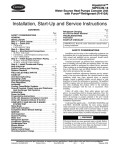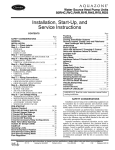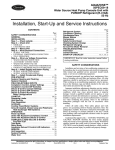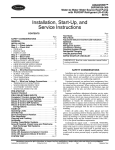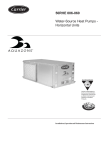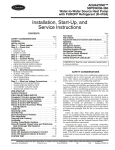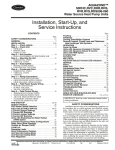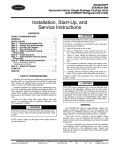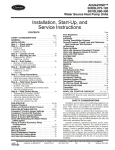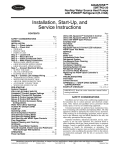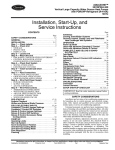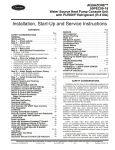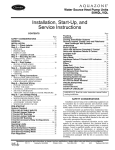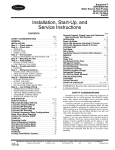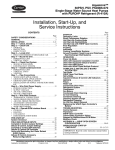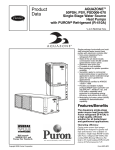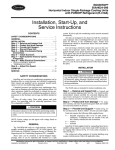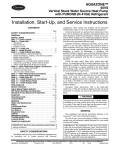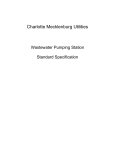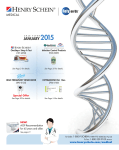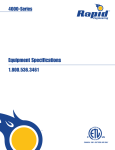Download Carrier aquazone 50RTG Instruction manual
Transcript
TM Rooftop Water Source Heat Pump Units 50RTG Installation, Start-Up, and Service Instructions CONTENTS Page SAFETY CONSIDERATIONS . . . . . . . . . . . . . . . . . . .1,2 GENERAL . . . . . . . . . . . . . . . . . . . . . . . . . . . . . . . . . . . . . . . . 2 INSTALLATION . . . . . . . . . . . . . . . . . . . . . . . . . . . . . 2-14 Step 1 — Check Jobsite . . . . . . . . . . . . . . . . . . . . . . . . 2 Step 2 — Check Unit . . . . . . . . . . . . . . . . . . . . . . . . . . . 2 • STORAGE • PROTECTION • INSPECT UNIT Step 3 — Location of Unit . . . . . . . . . . . . . . . . . . . . . . . . 3 Step 4 — Mounting the Unit . . . . . . . . . . . . . . . . . . . . . . 6 Step 5 — Condensate Drain . . . . . . . . . . . . . . . . . . . . . . 6 Step 6 — Piping Connections . . . . . . . . . . . . . . . . . . . . 6 • WATER LOOP APPLICATIONS • GROUND-WATER APPLICATIONS • GROUND-LOOP APPLICATIONS Step 7 — Electrical Wiring. . . . . . . . . . . . . . . . . . . . . . . . 7 • SUPPLY VOLTAGE • 208-VOLT OPERATION • BLOWER SELECTION Step 8 — Low Voltage Wiring. . . . . . . . . . . . . . . . . . . . 14 • THERMOSTAT CONNECTIONS • WATER FREEZE PROTECTION • AIR COIL FREEZE PROTECTION • ACCESSORY CONNECTIONS • WATER SOLENOID VALVES PRE-START-UP . . . . . . . . . . . . . . . . . . . . . . . . . . . . . . . .14,15 System Checkout . . . . . . . . . . . . . . . . . . . . . . . . . . . . . 14 FIELD SELECTABLE INPUTS . . . . . . . . . . . . . . . .15,16 C Control Jumper Settings . . . . . . . . . . . . . . . . . . . . 15 C Control DIP Switches . . . . . . . . . . . . . . . . . . . . . . . 15 D Control Jumper Settings . . . . . . . . . . . . . . . . . . . . 15 D Control DIP Switches . . . . . . . . . . . . . . . . . . . . . . . 15 D Control Accessory Relay Configurations . . . . . 16 Water Valve (Slow Opening) . . . . . . . . . . . . . . . . . . . 16 Outside Air Damper (OAD) . . . . . . . . . . . . . . . . . . . . 16 START-UP . . . . . . . . . . . . . . . . . . . . . . . . . . . . . . . . . . . . 16-18 Operating Limits . . . . . . . . . . . . . . . . . . . . . . . . . . . . . . . . 16 Scroll Compressor Rotation. . . . . . . . . . . . . . . . . . . . . 17 Unit Start-Up Cooling Mode . . . . . . . . . . . . . . . . . . . . . 17 Unit Start-Up Heating Mode . . . . . . . . . . . . . . . . . . . . . 17 Flow Regulation. . . . . . . . . . . . . . . . . . . . . . . . . . . . . . . . . 17 Flushing . . . . . . . . . . . . . . . . . . . . . . . . . . . . . . . . . . . . . . . . 17 Antifreeze . . . . . . . . . . . . . . . . . . . . . . . . . . . . . . . . . . . . . . . 18 Cooling Tower/Boiler Systems . . . . . . . . . . . . . . . . . . 18 Ground Coupled, Closed Loop and Plateframe Heat Exchanger Well Systems . . . . . . . . . . . . . . . . 18 Page OPERATION . . . . . . . . . . . . . . . . . . . . . . . . . . . . . . . . . . . . . 19 Power Up Mode . . . . . . . . . . . . . . . . . . . . . . . . . . . . . . . . . 19 Units with Aquazone™ Complete C Control . . . . . 19 Units with Aquazone Deluxe D Control . . . . . . . . . . 19 SYSTEM TEST . . . . . . . . . . . . . . . . . . . . . . . . . . . . . . . .19,20 Test Mode . . . . . . . . . . . . . . . . . . . . . . . . . . . . . . . . . . . . . . . 19 Retry Mode. . . . . . . . . . . . . . . . . . . . . . . . . . . . . . . . . . . . . . 20 Aquazone Deluxe D Control LED Indicators . . . . . 20 SERVICE . . . . . . . . . . . . . . . . . . . . . . . . . . . . . . . . . . . . . 20-22 Filters . . . . . . . . . . . . . . . . . . . . . . . . . . . . . . . . . . . . . . . . . . . 20 Water Coil . . . . . . . . . . . . . . . . . . . . . . . . . . . . . . . . . . . . . . . 20 Condensate Drain Pans . . . . . . . . . . . . . . . . . . . . . . . . . 21 Refrigerant System. . . . . . . . . . . . . . . . . . . . . . . . . . . . . . 21 Condensate Drain Cleaning . . . . . . . . . . . . . . . . . . . . . 21 Air Coil Cleaning . . . . . . . . . . . . . . . . . . . . . . . . . . . . . . . . 21 Condenser Cleaning . . . . . . . . . . . . . . . . . . . . . . . . . . . . 21 Checking System Charge . . . . . . . . . . . . . . . . . . . . . . . 22 Refrigerant Charging. . . . . . . . . . . . . . . . . . . . . . . . . . . . 22 Air Coil Fan Motor Removal . . . . . . . . . . . . . . . . . . . . . 22 TROUBLESHOOTING. . . . . . . . . . . . . . . . . . . . . . . . . 22-25 Thermistor . . . . . . . . . . . . . . . . . . . . . . . . . . . . . . . . . . . . . . 22 Control Sensors. . . . . . . . . . . . . . . . . . . . . . . . . . . . . . . . . 22 START-UP CHECKLIST . . . . . . . . . . . . . . . . . . CL-1, CL-2 IMPORTANT: Read the entire instruction manual before starting installation. SAFETY CONSIDERATIONS Installation and servicing of air-conditioning equipment can be hazardous due to system pressure and electrical components. Only trained and qualified service personnel should install, repair, or service air-conditioning equipment. Untrained personnel can perform basic maintenance functions of cleaning coils and filters and replacing filters. All other operations should be performed by trained service personnel. When working on air-conditioning equipment, observe precautions in the literature, tags and labels attached to the unit, and other safety precautions that may apply. Improper installation, adjustment, alteration, service, maintenance, or use can cause explosion, fire, electrical shock or other conditions which may cause personal injury or property damage. Consult a qualified installer, service agency, or your distributor or branch for information or assistance. The qualified installer or agency must use factory-authorized kits or accessories when modifying this product. Refer to the individual instructions packaged with the kits or accessories when installing. Manufacturer reserves the right to discontinue, or change at any time, specifications or designs without notice and without incurring obligations. PC 111 Catalog No. 535-004 Printed in U.S.A. Form 50R-2SI Pg 1 8-02 Replaces: New Book 1 4 Tab 5a 5a damage not discovered during unloading must be reported to the shipping company within 15 days of receipt of shipment. NOTE: It is the responsibility of the purchaser to file all necessary claims with the shipping company. 1. Verify unit is correct model for entering water temperature of job. 2. Be sure to provide freeze protection for piping, as required. Well water applications are especially susceptible to freezing. 3. Be sure the installation location is isolated from sleeping areas, private offices and other acoustically sensitive spaces. 4. Check local codes to be sure a secondary drain pan is not required under the unit. 5. Be sure unit is mounted at a height sufficient to provide an adequate slope of the condensate lines. If an appropriate slope cannot be achieved, a field-supplied condensate pump may be required. 6. Provide sufficient space for duct connection. 7. Provide adequate clearance for filter replacement and drain pan cleaning. Do not allow piping, conduit, etc. to block filter access. 8. Provide sufficient access to allow maintenance and servicing of the fan and fan motor, compressor and coils. 9. Provide an unobstructed path to the unit. Space should be sufficient to allow removal of unit if necessary. 10. Provide ready access to water valves and fittings, and screwdriver access to unit side panels, discharge collar, and all electrical connections. 11. Where access to side panels is limited, pre-removal of the control box side mounting screws may be necessary for future servicing. STORAGE — If the equipment is not installed immediately upon its arrival at the jobsite, it should be left in its shipping carton and stored in a clean, dry area of the building or in a warehouse. Units must be stored in an upright position at all times. If unit stacking is necessary, stack 50RTG03-10 units a maximum of 2 high. Do not stack units larger than 50RTG10. Do not remove any equipment from its shipping package until it is needed. PROTECTION — Once the units are properly positioned on the jobsite, they must be covered with either a shipping carton, vinyl film, or an equivalent protective covering. Open ends of pipes stored on the jobsite must be capped. This precaution is especially important in areas where painting, plastering, or spraying of fireproof material, etc. is not yet complete. Foreign material that is allowed to accumulate within the units can prevent proper start-up and necessitate costly clean-up operations. Before installing any of the system components, be sure to examine each pipe, fitting, and valve, and remove any dirt or foreign material found in or on these components. Follow all safety codes. Wear safety glasses and work gloves. Use quenching cloth for brazing operations. Have fire extinguisher available. Read these instructions thoroughly and follow all warnings or cautions attached to the unit. Consult local building codes and the National Electrical Code (NEC) for special installation requirements. Understand the signal words — DANGER, WARNING, and CAUTION. DANGER identifies the most serious hazards which will result in severe personal injury or death. WARNING signifies hazards that could result in personal injury or death. CAUTION is used to identify unsafe practices, which would result in minor personal injury or product and property damage. Recognize safety information. This is the safety-alert symbol ( ). When you see this symbol on the unit and in instructions or manuals, be alert to the potential for personal injury. Electrical shock can cause personal injury or death. Before installing or servicing system, always turn off main power to system. There may be more than one disconnect switch. Turn off accessory heater power if applicable. GENERAL This Installation and Start-Up Instructions literature is for Aquazone™ Rooftop Water Source Heat Pump systems. Rooftop Water Source Heat Pumps (WSHP) are singlepackage outdoor units with electronic controls designed for year-round cooling and heating. IMPORTANT: The installation of water source heat pump units and all associated components, parts, and accessories which make up the installation shall be in accordance with the regulations of ALL authorities having jurisdiction and MUST conform to all applicable codes. It is the responsibility of the installing contractor to determine and comply with ALL applicable codes and regulations. INSTALLATION Step 1 — Check Jobsite — Installation, operation and maintenance instructions are provided with each unit. Before unit start-up, read all manuals and become familiar with the unit and its operation. Thoroughly check out the system before operation. Complete the inspections and instructions listed below to prepare a unit for installation. See Table 1 for unit physical data. To avoid equipment damage, do not use these units as a source of heating or cooling during the construction process. The mechanical components and filters used in these units quickly becomes clogged with construction dirt and debris which may cause system damage. DO NOT store or install units in corrosive environments or in locations subject to temperature or humidity extremes (e.g., attics, garages, rooftops, etc.). Corrosive conditions and high temperature or humidity can significantly reduce performance, reliability, and service life. Always move units in an upright position. Tilting units on their sides may cause equipment damage. Step 2 — Check Unit — Upon receipt of shipment at the jobsite, carefully check the shipment against the bill of lading. Make sure all units have been received. Inspect the carton or crating of each unit, and inspect each unit for damage. Ensure the shipping company makes proper notation of any shortages or damage on all copies of the freight bill. Concealed 2 7. Remove any blower support cardboard from inlet of the blower if present. 8. Locate and verify any accessory kit located in compressor section. 9. Remove any access panel screws that may be difficult to remove once unit is installed. INSPECT UNIT — To prepare the unit for installation, complete the procedures listed below: 1. Compare the electrical data on the unit nameplate with ordering and shipping information to verify that the correct unit has been shipped. 2. Verify that the unit is the correct model for the entering water temperature of the job. 3. Do not remove the packaging until the unit is ready for installation. 4. Verify that the refrigerant tubing is free of kinks or dents, and that it does not touch other unit components. 5. Inspect all electrical connections. Be sure connections are clean and tight at the terminals. 6. Compressors are internally spring-mounted. Compressors equipped with external spring vibration isolators must have bolts loosened and shipping clamps removed. Step 3 — Location of Unit — The following guidelines should be considered when choosing a location for WSHP. Refer to Fig. 1 and 2 for unit dimensional data: • Provide sufficient space for water, electrical and duct connections • Locate unit in an area that allows for easy access and removal of filter and access panels • Allow enough space for service personnel to perform maintenance Table 1 — Physical Data — Aquazone™ 50RTG03-20 Units UNIT 50RTG OPERATING WEIGHT (lb) SHIPPING WEIGHT (lb) REFRIGERANT TO AIR HEAT EXCHANGER Face Area (sq ft) Rows Deep Copper Tube Size (in.) No. Fins per Inch REFRIGERANT CHARGE R-22/Ckt (oz) NUMBER OF CIRCUITS BLOWER DATA Diameter (qty-in.) Width (in.) FILTER DATA Size (in.) Quantity 03 735 750 5 2 04 785 800 07 880 900 08 1080 1100 10 1125 1150 12 1175 1200 15 1770 1800 5 3 9.3 3 3/ 8 12 68 2 9.3 3 3/ 8 12 86 2 10.5 3 3/ 8 12 88 2 12 141 2 12 160 2 3/ 8 3/ 12 68 1 12 86 1 7.5 3 3/ 8 12 132 1 1-10 6 1-10 6 1-10 10 1-12 11 1-15 11 1-15 11 1-15 11 2-15 11 2-15 11 16 x 20 4 16 x 20 4 16 x 20 4 16 x 20 4 16 x 20 6 16 x 20 6 16 x 20 6 16 x 20 10 16 x 20 6 3 8 20 4 20 1960 2000 3/ 8 12 52 1 5 3 05 835 850 3/ 8 20 4 3/ 8 4 39.52 45.40 45.40 50.62 05 07 08 10/12 15/20 A 39.52 39.52 03/04 A 50RTG UNITS 88.00 49.90 49.90 43.90 43.90 43.90 B 91.07 91.07 91.07 81.00 81.00 81.00 C 4.692 E 4.543 5.692 5.692 4.692 4.692 B FRONT VIEW 16.48 16.48 16.48 12.32 12.32 12.32 D 6.566 6.614 6.614 6.614 6.614 6.614 F DIMENSIONS (in.) 18.95 x 74.00 18.95 x 36.00 18.95 x 36.00 12.57 x 30.00 12.57 x 30.00 Outside Air Opening Size 12.57 x 30.00 2 11/2 11/4 11/4 1 E 5-13/16 F 9-13/16 TOP VIEW SUPPLY AIR SIDE VIEW SUPPLY AIR Fig. 1 — 50RTG Dimensional Data ELECTRICAL & PIPE CHASE Water In/Out (FPT) 3/ 4 C CONDENSATE DRAIN 1" FPT AIR FLOW RETURN AIR RETURN AIR OUTSIDE AIR D OUTSIDE AIR OPENING NOTES: 1. All dimensions are in inches. 2. Carrier works continuously to improve its products. As a result, the design and specification of each product at the time of order may be changed without notice. 3. Assembly tolerances ± 1/8. 5 14.00 (REF) 2.00 TYP. 23.000 A B C H G 3.000 (TYP) TRANSITION DETAIL (FIELD SUPPLIED) SUPPLY AIR TRANSITION K J RETURN AIR TRANSITION HEIGHT DETERMINED BY CONTRACTOR'S REQUIREMENTS 3.000 (TYP) 14.00 (REF) STRUCTURAL SUPPORT CURB WALL BASE PAN OF UNIT 3-7/8" F ROOF DECK/ROOFING FLASHING E IMPORTANT NOTE: WHEN INSTALLING CURB, FLASHING MUST CONFORM TO THE NOTED DIMENSIONS. THIS IS TO ALLOW CLEARANCE FOR MOUNTING UNIT TO CURB. Fig. 2 — 50RTG Roof Curb Dimensional Data 14-15/16 Return Air DIMENSIONS (in.) Return Air Transition Supply Air Transition A B C E F G H J K G H J K 35.25 72.25 18.00 1.50 12.50 22.00 16.00 39.25 33.25 27.00 21.00 39.25 33.25 41.25 82.25 21.00 1.50 12.50 25.00 19.00 45.25 39.25 27.00 21.00 45.25 39.25 78.875 82.25 21.00 5.00 9.00 25.00 19.00 82.875 76.875 27.00 21.00 82.875 76.875 Supply Air 50RTGACURBCAAA 50RTGACURBBAAA 50RTGACURBAAAA ROOF CURB ROOF CURB ASSEMBLY DETAILS Step 4 — Mounting the Unit — For proper operation, units must be mounted on a roof curb as shown in Fig. 3. Follow these guidelines when installing the roof curb: 1. Set unit on curb. 2. Align unit so that its return and supply air direction match the return and supply air opening in the roof curb frame. 3. Run both the return and supply loop piping, as well as the electrical supply line, through the pipe chase provided in the curb. WATER LOOP APPLICATIONS — Water loop applications usually include a number of units plumbed to a common piping system. Maintenance to any of these units can introduce air into the piping system. Therefore, air elimination equipment comprises a major portion of the mechanical room plumbing. The flow rate is usually set between 2.25 and 3 gpm per ton of cooling capacity. For proper maintenance and servicing, pressure-temperature (P/T) ports are necessary for temperature and flow verification. In addition to complying with any applicable codes, consider the following for system piping: • Piping systems utilizing water temperatures below 50 F require 1/2-in. closed cell insulation on all piping surfaces to eliminate condensation. • All plastic to metal threaded fittings should be avoided due to the potential to leak. Use a flange fitted substitute. • Teflon tape thread sealant is recommended to minimize internal fouling of the heat exchanger. • Use backup wrench. Do not overtighten connections. • Route piping to avoid service access areas to unit. • The piping system should be flushed prior to operation to remove dirt and foreign materials from the system. GROUND-WATER APPLICATIONS — In addition to complying with any applicable codes, consider the following for system piping: • Install shut-off valves for servicing. • Install pressure-temperature plugs to measure flow and temperature. • Boiler drains and other valves should be connected using a “T” connector to allow acid flushing for the heat exchanger. • Do not overtighten connections. • Route piping to avoid service access areas to unit. • Use PVC SCH80 or copper piping material. NOTE: PVC SCH40 should not be used due to system high pressure and temperature extremes. Water Supply and Quantity — Check water supply. Water supply should be plentiful and of good quality. See Table 2 for water quality guidelines. Step 5 — Condensate Drain 1. Install a condensate trap at each unit with the top of the trap positioned below the unit condensate drain connection. 2. Design the length of the trap (water seal) based on the amount of positive or negative pressure on the drain pan. As a rule, 1 in. of trap is required for each inch of negative pressure on the unit. Note that condensate is allowed to drain onto the roof. Step 6 — Piping Connections — Depending on the application, there are 3 types of WSHP piping systems to choose from: water loop, ground-water and ground loop. Refer to Piping Section of Carrier System Design Manual for additional information. All WSHP units use low temperature soldered female pipe thread fittings for water connections to prevent annealing and out-of-round leak problems which are typically associated with high temperature brazed connections. Refer to Table 1 for connection sizes. When making piping connections, consider the following: • Use a backup wrench when making screw connections to unit to prevent internal damage to piping. • Insulation may be required on piping to avoid condensation in the case where fluid in loop piping operates at temperatures below dew point of adjacent air. • Piping systems that contain steel pipes or fittings may be subject to galvanic corrosion. Dielectric fittings may be used to isolate the steel parts of the system to avoid galvanic corrosion. IMPORTANT: Failure to comply with the above required water quality and quantity limitations and the closedsystem application design requirements may cause damage to the tube-in-tube heat exchanger that is not the responsibility of the manufacturer. 50 RTG UNIT In all applications, the quality of the water circulated through the heat exchanger must fall within the ranges listed in the Water Quality Guidelines table. Consult a local water treatment firm, independent testing facility, or local water authority for specific recommendations to maintain water quality within the published limits. GROUND-LOOP APPLICATIONS — Temperatures between 25 to 110 F and a cooling capacity of 2.25 to 3 gpm of flow per ton is recommended. In addition to complying with any applicable codes, consider the following for system piping: • Piping materials should be limited to only polyethylene fusion in the buried sections of the loop. • Galvanized or steel fittings should not be used at any time due to corrosion. • All plastic to metal threaded fittings should be avoided due to the potential to leak. Use a flange fitted substitute. • Do not overtighten connections. • Route piping to avoid service access areas to unit. • Pressure-temperature (P/T) plugs should be used to measure flow of pressure drop. FLASHING GASKET ROOF CURB Fig. 3 — 50RTG Curb Installation 6 Step 7 — Electrical Wiring AB = 452 volts BC = 464 volts AC = 455 volts Average Voltage = To avoid possible injury or death due to electrical shock, open the power supply disconnect switch and secure it in an open position during installation. = 1371 3 = 457 Determine maximum deviation from average voltage: (AB) 457 – 452 = 5 v (BC) 464 – 457 = 7 v (AC) 457 – 455 = 2 v Maximum deviation is 7 v. Determine percent voltage imbalance. Use only copper conductors for field-installed electrical wiring. Unit terminals are not designed to accept other types of conductors. All field installed wiring, including the electrical ground, MUST comply with the National Electrical Code (NEC) as well as applicable local codes. In addition, all field wiring must conform to the Class II temperature limitations described in the NEC. Refer to unit wiring diagram Fig. 4 for a schematic of the field connections which must be made by the installing (or electrical) contractor. Consult the unit wiring diagram located on the inside of the compressor access panel to ensure proper electrical hookup. The installing (or electrical) contractor must make the field connections when using field-supplied disconnect. Operating voltage must be the same voltage and phase as shown in Electrical Data shown in Table 3. Make all final electrical connections with a length of flexible conduit to minimize vibration and sound transmission to the building. SUPPLY VOLTAGE — Operating voltage to unit must be within voltage range indicated on unit nameplate. On 3-phase units, voltages under load between phases must be balanced within 2%. Use the following formula to determine the percentage voltage imbalance: % Voltage Imbalance = 100 x 452 + 464 + 455 3 % Voltage Imbalance = 100 x 7 457 = 1.53% This amount of phase imbalance is satisfactory as it is below the maximum allowable 2%. Operation on improper line voltage or excessive phase imbalance constitutes abuse and may cause damage to electrical components. NOTE: If more than 2% voltage imbalance is present, contact local electric utility. 208-VOLT OPERATION — All 208-230 volt units are factory wired for 208 volts. The transformers may be switched to 230-volt operation (as illustrated on the wiring diagram) by switching the red (208 volt) wire with the orange (230 volt) wire at the L1 terminal. BLOWER SELECTION — All water source heat pumps are factory set with the appropriate motor and sheave combination to achieve the desired airflow performance. Performance is selected by matching the desired performance with the appropriate region in Tables 4-12. Per the table notes, regions designated by A, B, C and D represent motor drive options. NOTE: Factory-installed sheaves are field adjustable. Refer to Tables 4-12 for adjustment points. max voltage deviation from average voltage average voltage Example: Supply voltage is 460-3-60. Table 2 — Water Quality Guidelines CONDITION pH Total Hardness Iron Oxides Iron Bacteria Corrosion* Brackish ACCEPTABLE LEVEL 7 to 9 range for copper. Cupro-nickel may be used in the 5 to 9 range. Calcium and magnesium carbonate should not exceed 20 grains per gallon (350 ppm). Less than 1 ppm. No level allowable. Max Allowable Level Coaxial Metal Ammonia, Ammonium Hydroxide 0.5 ppm Cu Ammonium Chloride, Ammonium Nitrate 0.5 ppm Cu Ammonium Sulfate 0.5 ppm Cu Chlorine/Chlorides 0.5 ppm CuNi Hydrogen Sulfide† None Allowable — Use Cupro-nickel heat exchanger when concentrations of calcium or sodium chloride are greater than 125 ppm are present. (Seawater is approximately 25,000 ppm.) *If the concentration of these corrosives exceeds the maximum allowable level, then the potential for serious corrosion problems exists. †Sulfides in the water quickly oxidize when exposed to air, requiring that no agitation occur as the sample is taken. Unless tested immediately at the site, the sample will require stabilization with a few drops of one Molar zinc acetate solution, allowing accurate sulfide determination up to 24 hours after sampling. A low pH and high alkalinity cause system problems, even when both values are within ranges shown. The term pH refers to the acidity, basicity, or neutrality of the water supply. Below 7.0, the water is considered to be acidic. Above 7.0, water is considered to be basic. Neutral water contains a pH of 7.0. NOTE: To convert ppm to grains per gallon, divide by 17. Hardness in mg/l is equivalent to ppm. 7 50RTG03-07 WITH ECONOMIZER AND COMPLETE C CONTROLLER WHT 115V / 1PH Ground BLK L1 L1 BLK L2 BLK L2 BLK BLK L3 BLK L3 T2 L3 Power Distribution Block Disconnect OR CB (Optional) BLK T1 L2 BLK GRN Field Wiring L1 BLK Power Supply Refer to Data Plate Use copper conductors only. BLK GFI (Optional) T3 Compressor CC BLK BLK BLK BLK BLK BLK Blower Motor BC ES Logic Module (Damper Actuator) - + GRY MAS GRY BLU BRN 600 Ohm TR1 + + TR SO SR 150 Ohm 5 2 4 1 3 T1 P1 BRN LAR 4 GRY RED (208V) 3 VIO or BLK/RED (460V) BLU or BLK BC BRN BR BLU 24V CB BRG BRN YEL Test Pins ECR P2 Compressor Relay P1 SEE NOTE 4 Y FP1 W Cooling FP2 O Fan G Dip Switch 1 PM 2 Not Used Off On R Alarm L AL1 Typical T-stat SEE NOTE 5 AL2 A 2 3 RED 4 5 BRN 6 7 GRY G Status LED BLU GRY FP1 BRN LAR BRN LOC FP1 RVS VIO VIO 8 9 BRN 10 ORG RV FP2 BRN ORG ECR Not Used JW1 C Alarm SEE NOTE 6 Relay B TAN HP FP2 C RED LOC G Common 1 HP 24 VAC C CC 6 R C YEL Compressor R 8 7 WHT Y O YEL YEL 3 SEE NOTE 7 CC CCG R Y 2 BLK OAT SEE NOTE 3 ORG 230V 4 BRN GRY P VIO YEL SEE NOTE 7 T CO 12 Microprocessor Control Logic P3 24V DC EH1 EH2 CO LEGEND AL BC CB CC ECR EH1 EH2 ES FP1 FP2 HP JW1 LAR LOC MAS NEC OAT — — — — — — — — — — — — — — — — — Alarm Relay Contacts Blower Mtr Contactor Circuit Breaker Compressor Contactor Economizer Relay Auxiliary Heat Stage 1 Auxiliary Heat Stage 2 Enthalpy Sensor Sensor, Water Coil Freeze Protection Sensor, Air Coil Freeze Protection High Pressure Switch Jumper, Alarm Mode Low Ambient Relay Loss-of-Charge Pressure Switch Mixed Air Sensor National Electrical Code Outside Air Thermostat PM — Performance Monitor P1 — Field Wiring Terminal Block RVS — Reversing Valve Solenoid Relay Contactor Coil Solenoid Coil Thermistor Ground Field Line Voltage Wiring Field Low Voltage Wiring Printed Circuit Trace NOTES: 1. Compressor and blower motor thermally protected internally. 2. All wiring to the unit must comply with NEC and local codes. 3. 208/230 v transformers will be connected for 208 v operations. For 230 v operations, disconnect Red lead at L1, and attach Orange lead to L1. Close open end of Red Lead with insulating tape. 4. FP1 jumper provides freeze protection for WATER. When using ANTI-FREEZE solutions, cut FP1 jumper. 5. Typical thermostat wiring shown. Refer to thermostat Installation Instructions for wiring to the unit. 6. 24 v alarm signal shown. For dry alarm contact, cut JW1 jumper and dry contact will be available between AL1 and AL2. 7. Transformer secondary ground via Complete C board standoffs and screws to control box. (Ground available from top two standoffs as shown.) Fig. 4 — Typical Aquazone™ Complete C Control Wiring 8 Table 3 — 50RTG Electrical Data UNIT 50RTG 03 04 05 07 08 10 12 15 20 FLA HACR LRA RLA — — — — POWER SUPPLY Voltage Hz 208/230 60 460 60 208/230 60 460 60 575 60 208/230 60 460 60 575 60 208/230 60 460 60 575 60 208/230 60 460 60 575 60 208/230 60 460 60 575 60 208/230 60 460 60 575 60 208/230 60 460 60 575 60 208/230 60 460 60 575 60 COMPRESSOR (each) RLA LRA QTY 10.7 63.0 1 5.0 31.0 1 13.9 88.0 1 6.4 44.0 1 5.3 34.0 1 20.0 123.0 1 7.5 49.5 1 6.4 40.0 1 20.7 156.0 1 10.0 70.0 1 8.2 54.0 1 13.9 88.0 2 6.4 44.0 2 5.3 34.0 2 20.0 123.0 2 7.5 49.5 2 6.4 40.0 2 19.3 123.0 2 10.0 62.0 2 7.8 50.0 2 20.7 156.0 2 10.0 70.0 2 8.2 54.0 2 33.3 232.0 2 17.0 116.0 2 12.8 97.0 2 Ph 3 3 3 3 3 3 3 3 3 3 3 3 3 3 3 3 3 3 3 3 3 3 3 3 3 3 HP 1 1 1 1 1 1 1 1 2 2 2 2 2 2 2 2 2 3 3 3 3 3 3 5 5 5 BLOWER MOTOR FLA QTY 3.6 1 1.8 1 3.6 1 1.8 1 1.6 1 3.6 1 1.8 1 1.6 1 6.2 1 3.1 1 2.3 1 6.2 1 3.1 1 2.3 1 6.2 1 3.1 1 2.3 1 9.2 1 4.3 1 3.4 1 9.2 1 4.3 1 3.4 1 13.2 1 6.6 1 5.6 1 MAX. FUSE OR HACR BREAKER 25 Amp 15 Amp 30 Amp 15 Amp 15 Amp 45 Amp 15 Amp 15 Amp 50 Amp 25 Amp 20 Amp 50 Amp 20 Amp 15 Amp 70 Amp 25 Amp 20 Amp 70 Amp 35 Amp 25 Amp 70 Amp 35 Amp 30 Amp 125 Amp 60 Amp 45 Amp MINIMUM CIRCUIT AMPACITY 17.0 8.1 21.0 9.8 8.2 28.6 11.2 9.6 32.1 15.6 12.6 37.5 17.5 14.2 51.2 20.0 16.7 52.6 26.8 21.0 55.8 26.8 21.9 88.1 44.9 34.4 LEGEND Full Load Amps Heating, Air Conditioning and Refrigeration Lock Rotor Amps Rated Load Amps NOTE: Contact factory for oversize blower motor electrical data. Table 4 — 50RTG03 Blower Performance SCFM AIRFLOW 975 1050 1125 1200 1275 1350 1425 BHP RPM Turns Out BHP RPM Turns Out BHP RPM Turns Out BHP RPM Turns Out BHP RPM Turns Out BHP RPM Turns Out BHP RPM Turns Out 0.1 0.12 550 5.0 0.14 580 4.0 0.18 619 3.5 0.22 658 4.5 0.26 688 4.0 0.29 721 3.5 0.4 763 3.0 B 0.2 0.14 609 3.5 0.17 636 3.0 0.20 670 4.5 0.24 705 4.00 0.29 732 3.5 0.32 764 3.0 0.40 803 2.5 0.3 0.17 667 4.5 0.19 691 4.0 0.23 721 3.5 0.26 752 3.00 0.31 777 2.5 0.35 807 2.5 0.42 843 1.5 EXTERNAL STATIC PRESSURE (in. wg) 0.4 0.5 0.6 0.7 0.19 0.21 0.23 0.26 724 779 833 885 3.5 2.5 1.5 1.0 0.22 0.24 0.26 0.30 745 798 849 898 3.0 2.5 1.5 0.5 0.25 0.28 0.31 0.33 772 821 870 917 3.0 2.0 1.0 0.5 0.29 0.32 0.35 0.37 799 846 892 937 2.5 1.5 1.0 0.0 0.33 0.36 0.40 0.42 822 867 911 954 2.0 1.5 0.5 2.5 0.39 0.41 0.44 0.47 850 893 935 976 1.5 1.0 0.0 2.0 0.44 0.46 0.50 0.53 883 923 963 1003 1.0 0.5 2.5 2.0 A LEGEND BHP — Brake Horsepower SCFM — Standard Cubic Feet Per Minute NOTES: 1. Fan BHP includes drive losses. 2. Region “A” is standard drive package. 3. Regions “B” and “C” require optional drive packages. 4. For applications requiring higher static pressures, contact your local representative. 9 0.8 0.29 933 0.0 0.32 946 0.0 0.36 963 2.5 0.41 982 2.0 0.45 997 2.0 0.51 1017 1.4 0.56 1041 1.5 C 0.9 0.31 980 2.0 0.35 991 2.0 0.39 1008 2.0 0.44 1025 1.5 0.48 1038 1.5 0.54 1057 1.0 0.61 1080 1.0 1.0 0.33 1024 1.5 0.37 1035 1.5 0.42 1051 1.0 0.46 1066 1.0 0.52 1079 1.0 0.57 1096 0.5 0.64 1118 0.5 Table 5 — 50RTG04 Blower Performance SCFM AIRFLOW 1300 1400 1500 1600 1700 1800 1900 BHP RPM Turns Out BHP RPM Turns Out BHP RPM Turns Out BHP RPM Turns Out BHP RPM Turns Out BHP RPM Turns Out BHP RPM Turns Out 0.1 0.26 633 5 0.33 668 4 0.418 712 3.0 0.506 750 4.5 0.572 792 4.0 0.671 832 3.0 0.80 875 2.5 B 0.2 0.30 694 3.5 0.36 725 3.0 0.45 766 4.5 0.54 801 3.5 0.62 840 3.0 0.72 878 2.5 0.85 919 1.5 0.3 0.33 755 4.5 0.40 782 4.0 0.48 819 3.5 0.57 851 3.0 0.66 887 2.0 0.76 923 1.5 0.89 961 1.0 EXTERNAL STATIC PRESSURE (in. wg) 0.4 0.5 0.6 0.7 0.8 0.9 1.0 0.36 0.40 0.42 812 869 925 3.5 2.5 1.5 0.43 0.46 0.50 0.53 Operation Not Recommended 836 890 943 995 3.0 2.0 1.0 0.5 0.52 0.55 0.58 0.62 0.65 871 922 970 1017 1063 2.5 1.5 0.5 3.5 3.0 0.61 0.67 0.70 0.75 0.78 0.83 0.64 900 948 995 1040 1083 1125 1166 2.0 1.0 0.0 3.5 1.5 2.0 1.5 0.70 0.74 0.78 0.81 0.86 0.89 0.94 934 979 1024 1068 1110 1152 1194 1.5 0.5 3.5 3.0 2.5 1.5 1.0 0.80 0.85 0.89 0.94 0.97 1.01 1.06 967 1010 1053 1095 1136 1176 1219 1.0 0.0 3.0 2.5 2.0 1.5 1.0 0.94 0.98 1.02 1.07 1.11 1.16 1.20 1003 1045 1086 1127 1166 1204 1242 0.0 3.0 2.5 2.0 1.5 1.0 0.5 A C D LEGEND BHP — Brake Horsepower SCFM — Standard Cubic Feet Per Minute NOTES: 1. Fan BHP includes drive losses. 2. Region “A” is standard drive package. 3. Regions “B” and “C” require optional drive packages. 4. Region “D” represents oversized motor and special sheaves. 5. For applications requiring higher static pressures, contact your local representative. Table 6 — 50RTG05 Blower Performance SCFM AIRFLOW 1700 1800 1900 2000 2100 2200 2300 BHP RPM Turns Out BHP RPM Turns Out BHP RPM Turns Out BHP RPM Turns Out BHP RPM Turns Out BHP RPM Turns Out BHP RPM Turns Out 0.1 0.37 797 3.5 0.44 836 2.5 0.52 880 1.5 0.61 926 3.5 0.69 966 3.0 0.79 1009 2.0 0.9 1055 1.0 B 0.2 0.42 845 2.5 0.48 882 1.5 0.56 923 3.5 0.65 967 3.0 0.74 1005 2.0 0.84 1047 1.5 0.96 1091 4.5 0.3 0.45 892 1.5 0.53 927 3.5 0.61 966 3.0 0.69 1007 2.0 0.78 1044 1.5 0.89 1084 1.0 1.00 1126 4.0 EXTERNAL STATIC PRESSURE (in. wg) 0.4 0.5 0.6 0.7 0.8 0.50 0.54 0.58 0.63 0.67 938 984 1029 1072 1114 3.0 2.5 1.5 1.0 0.5 0.56 0.61 0.65 0.70 0.75 971 1015 1057 1099 1140 2.5 2.0 1.0 0.5 0.5 0.65 0.69 0.74 0.78 0.84 1008 1049 1090 1131 1170 2.0 1.5 0.5 0.5 0.0 0.74 0.78 0.84 0.88 0.94 1047 1087 1126 1164 1203 1.5 1.0 0.5 0.0 3.0 0.84 0.88 0.94 0.98 1.03 1082 1120 1158 1195 1231 1.0 0.5 0.0 3.0 2.5 0.94 0.99 1.05 1.09 1.14 1120 1157 1193 1229 1264 0.5 3.5 3.0 2.5 2.0 1.06 1.11 1.17 1.22 1.28 1161 1196 1231 1265 1299 3.5 3.0 2.5 2.0 1.5 0.9 Operation Not Recommended A LEGEND BHP — Brake Horsepower SCFM — Standard Cubic Feet Per Minute NOTES: 1. Fan BHP includes drive losses. 2. Region “A” is standard drive package. 3. Regions “B” and “C” require optional drive packages. 4. Region “D” represents oversized motor and special sheaves. 5. For applications requiring higher static pressures, contact your local representative. 10 1.0 D 0.79 1180 0.0 0.88 1208 3.0 0.98 1240 2.5 1.09 1268 2.0 1.20 1298 1.5 1.33 1332 1.0 C 0.94 1246 2.5 1.03 1277 2.0 1.14 1303 1.5 1.25 1333 1.0 1.39 1365 0.5 Table 7 — 50RTG07 Blower Performance SCFM AIRFLOW 1950 2200 2400 2600 2800 3000 3250 BHP RPM Turns Out BHP RPM Turns Out BHP RPM Turns Out BHP RPM Turns Out BHP RPM Turns Out BHP RPM Turns Out BHP RPM Turns Out 0.2 0.42 620 4.5 0.56 675 3 0.70 721 2.0 0.87 765 4 1.07 812 3.5 1.28 857 2.5 1.60 915 1.0 0.3 0.46 664 3.5 0.62 716 2.0 0.76 758 4.5 0.94 800 3.5 1.13 845 2.5 1.35 889 1.5 1.67 945 0.5 B 0.4 0.51 707 2.5 0.67 755 4.5 0.83 795 3.5 0.99 835 3.0 1.20 877 2.0 1.42 919 1.0 1.75 974 5.0 0.5 0.56 750 4.5 0.73 793 3.5 0.88 830 3.0 1.06 868 2.0 1.27 908 1.5 1.50 949 0.5 1.83 1001 4.5 EXTERNAL STATIC PRESSURE (in. wg) 0.6 0.7 0.8 0.9 1.0 1.1 1.2 1.3 1.4 0.62 0.67 0.73 0.78 792 832 870 908 Operation Not Recommended 3.5 2.5 2.0 1.5 0.78 0.85 0.90 0.97 1.03 1.10 1.17 831 869 905 941 975 1007 1038 3.0 2.0 1.5 0.5 5.0 3.0 2.5 0.95 1.00 1.07 1.14 1.21 1.28 1.34 1.41 865 900 935 969 1002 1034 1066 1097 2.0 1.5 0.5 0.0 4.5 4.0 3.5 3.0 1.12 1.19 1.25 1.33 1.40 1.47 1.55 1.63 1.69 901 933 965 997 1029 1060 1090 1120 1149 1.5 0.5 0.0 4.5 4.0 3.5 3.0 2.5 2.0 1.33 1.40 1.47 1.54 1.62 1.69 1.77 1.86 1.94 939 970 1000 1030 1059 1089 1118 1147 1175 0.5 5.0 4.5 4.0 3.5 3.0 2.5 2.0 1.5 1.56 1.64 1.72 1.79 1.87 1.95 2.02 2.11 2.20 978 1007 1035 1064 1091 1119 1147 1174 1202 5.0 4.5 4.0 3.5 3.0 2.5 2.0 1.5 1.0 1.90 1.98 2.06 2.13 2.22 2.30 2.39 2.48 2.56 1029 1056 1082 1109 1135 1161 1187 1212 1238 4.0 3.5 3.0 2.5 2.5 2.0 1.5 1.0 1.0 A C D 1.5 1.77 1178 1.5 2.01 1203 1.0 2.28 1228 1.0 2.65 1263 0.5 LEGEND BHP — Brake Horsepower SCFM — Standard Cubic Feet Per Minute NOTES: 1. Fan BHP includes drive losses. 2. Region “A” is standard drive package. 3. Regions “B” and “C” require optional drive packages. 4. Region “D” represents oversized motor and special sheaves. 5. For applications requiring higher static pressures, contact your local representative. Table 8 — 50RTG08 Blower Performance SCFM AIRFLOW 2400 2650 2900 3200 3450 3700 4000 BHP RPM Turns Out BHP RPM Turns Out BHP RPM Turns Out BHP RPM Turns Out BHP RPM Turns Out BHP RPM Turns Out BHP RPM Turns Out 0.2 0.40 482 4.5 0.51 514 4 0.64 549 2.5 0.81 588 5 1.00 623 3.5 1.20 657 2.5 1.47 699 1.5 B 0.3 0.45 521 3.5 0.56 550 2.5 0.69 583 4.5 0.88 619 3.5 1.07 652 3.0 1.28 685 2.0 1.56 725 1.0 0.4 0.50 559 2.0 0.62 585 4.5 0.76 615 4.0 0.95 649 3.0 1.14 681 2.0 1.35 712 1.0 1.64 750 0.0 A 0.5 0.55 594 4.5 0.67 619 3.5 0.83 647 3.0 1.02 679 2.0 1.21 709 1.5 1.43 739 0.5 1.73 775 5.0 EXTERNAL STATIC PRESSURE (in. wg) 0.6 0.7 0.8 0.9 1.0 1.1 0.61 0.66 0.72 0.77 0.83 0.87 629 661 693 723 751 779 3.5 2.5 1.5 1.0 0.0 4.5 0.74 0.79 0.86 0.91 0.98 1.05 651 683 713 742 770 797 3.0 2.0 1.0 0.5 4.5 4.0 0.88 0.95 1.01 1.08 1.14 1.22 677 707 736 764 791 818 2.0 1.5 0.5 5.0 4.5 4.0 1.09 1.16 1.23 1.30 1.38 1.45 707 735 763 789 815 841 1.5 0.5 5.0 4.5 4.0 3.5 1.29 1.36 1.44 1.52 1.60 1.67 736 763 789 814 839 863 0.5 5.0 4.5 4.0 3.5 3.0 1.51 1.60 1.67 1.75 1.84 1.91 764 790 815 839 863 886 5.0 4.5 4.0 3.5 3.0 2.5 1.82 1.89 1.98 2.07 2.16 2.24 799 823 847 870 892 915 4.5 4.0 3.5 3.0 2.5 2.0 LEGEND BHP — Brake Horsepower SCFM — Standard Cubic Feet Per Minute NOTES: 1. Fan BHP includes drive losses. 2. Region “A” is standard drive package. 3. Regions “B” and “C” require optional drive packages. 4. Region “D” represents oversized motor and special sheaves. 5. For applications requiring higher static pressures, contact your local representative. 11 1.2 0.91 806 4.0 1.10 823 3.5 1.29 843 3.5 1.52 865 3.0 1.75 887 2.5 2.00 909 2.0 2.33 937 1.5 C 1.3 0.98 832 3.5 1.16 848 3.0 1.35 868 3.0 1.60 890 2.5 1.83 911 2.0 2.08 932 1.5 2.42 958 1.0 D 1.4 1.03 858 3.0 1.21 872 2.5 1.42 894 2.5 1.67 913 2.0 1.90 934 1.5 2.17 954 1.0 2.51 980 0.5 1.5 1.10 883 2.5 1.27 895 2.0 1.49 915 2.0 1.74 936 1.5 1.99 956 1.0 2.26 976 0.5 2.61 1001 0.0 Table 9 — 50RTG10 Blower Performance SCFM AIRFLOW 3000 3300 3600 4000 4300 4700 5000 BHP RPM Turns Out BHP RPM Turns Out BHP RPM Turns Out BHP RPM Turns Out BHP RPM Turns Out BHP RPM Turns Out BHP RPM Turns Out 0.2 0.69 563 4.5 0.89 604 3 1.12 647 2.0 1.47 699 4.5 1.82 746 3.5 2.32 803 4.5 2.76 847 3.5 B 0.3 0.76 596 3.5 0.96 635 2.5 1.20 676 1.0 1.56 725 4.0 1.90 770 3.0 2.42 825 4.0 2.86 868 3.5 0.4 0.83 628 2.5 1.03 664 1.5 1.28 703 4.5 1.64 750 3.5 1.99 794 4.5 2.52 848 3.5 2.96 889 3.0 0.5 0.89 658 1.5 1.10 693 4.5 1.35 730 4.0 1.73 775 3.0 2.09 817 4.5 2.61 869 3.5 EXTERNAL STATIC PRESSURE (in. wg) 0.6 0.7 0.8 0.9 1.0 1.1 1.2 1.3 1.4 0.96 1.02 1.09 1.16 1.22 1.29 1.36 1.43 1.50 688 718 746 773 800 826 851 876 900 1.0 4.0 3.5 3.0 2.5 2.0 1.5 0.5 0.0 1.18 1.24 1.32 1.39 1.46 1.54 1.62 1.69 1.77 721 748 775 801 827 852 876 900 923 4.0 3.5 3.0 2.5 2.0 1.0 0.5 0.0 2.5 1.43 1.51 1.58 1.66 1.75 1.83 1.90 1.99 2.07 756 782 807 832 856 880 903 926 949 3.5 2.5 2.0 1.5 1.0 0.5 0.0 2.5 2.0 1.82 1.89 1.98 2.07 2.16 2.24 2.33 2.42 2.51 799 823 847 870 892 915 937 958 980 2.5 2.0 4.0 3.5 3.0 2.5 2.0 1.5 1.0 2.18 2.27 2.35 2.45 2.54 2.64 2.73 2.83 2.93 840 863 885 907 929 950 971 991 1012 4.0 3.5 3.0 2.5 2.0 1.5 1.0 1.0 0.5 2.71 2.81 2.90 891 912 933 3.0 2.5 2.0 Operation Not Recommended C A D 1.5 1.57 923 2.5 1.85 946 2.0 2.16 971 1.5 2.61 1001 0.5 LEGEND BHP — Brake Horsepower SCFM — Standard Cubic Feet Per Minute NOTES: 1. Fan BHP includes drive losses. 2. Region “A” is standard drive package. 3. Regions “B” and “C” require optional drive packages. 4. Region “D” represents oversized motor and special sheaves. 5. For applications requiring higher static pressures, contact your local representative. Table 10 — 50RTG12 Blower Performance SCFM AIRFLOW 3600 4000 4400 4800 5200 5600 6000 BHP RPM Turns Out BHP RPM Turns Out BHP RPM Turns Out BHP RPM Turns Out BHP RPM Turns Out BHP RPM Turns Out BHP RPM Turns Out 0.2 1.02 609 5.5 1.38 664 4.5 1.77 716 2.0 2.23 765 5.5 2.82 825 4.5 3.47 879 5.5 4.20 933 4.0 0.3 1.10 639 4.5 1.45 691 3.0 1.86 741 5.5 2.33 788 4.0 2.93 846 2.5 3.58 899 5.0 4.33 952 3.5 B 0.4 1.18 667 3.5 1.54 717 2.0 1.96 765 4.5 2.43 810 3.5 3.04 867 5.5 3.70 918 4.5 4.46 970 3.0 0.5 1.25 695 2.5 1.62 742 5.5 2.05 789 4.0 2.53 833 3.0 3.14 888 5.0 3.81 938 4.0 4.58 989 3.0 EXTERNAL STATIC PRESSURE (in. wg) 0.6 0.7 0.8 0.9 1.0 1.1 1.33 1.41 1.49 1.56 1.64 1.72 722 748 774 800 825 849 1.5 5.5 4.5 3.5 3.0 2.5 1.71 1.78 1.87 1.96 2.05 2.13 767 792 816 839 863 886 4.5 4.0 3.5 2.5 2.0 1.5 2.13 2.23 2.32 2.41 2.51 2.61 812 835 858 879 901 923 3.5 3.0 2.0 1.5 5.0 4.5 2.63 2.73 2.83 2.93 3.03 3.12 854 876 897 918 938 959 2.5 1.5 1.0 4.5 4.0 3.5 3.25 3.36 3.47 3.58 3.69 3.78 908 928 948 968 987 1006 4.5 4.0 3.5 3.5 3.0 2.5 3.93 4.04 4.16 4.27 4.39 4.51 957 976 995 1013 1031 1050 3.5 3.0 2.5 2.0 1.5 1.5 4.70 4.82 4.95 1007 1025 1042 2.5 2.0 1.5 A 1.2 1.80 873 1.5 2.22 908 4.5 2.70 944 4.0 3.23 978 3.0 3.89 1025 2.0 4.62 1067 1.0 D LEGEND BHP — Brake Horsepower SCFM — Standard Cubic Feet Per Minute NOTES: 1. Fan BHP includes drive losses. 2. Region “A” is standard drive package. 3. Regions “B” and “C” require optional drive packages. 4. Region “D” represents oversized motor and special sheaves. 5. For applications requiring higher static pressures, contact your local representative. 12 1.3 1.88 896 1.0 2.31 930 4.0 2.79 965 3.5 3.33 998 2.5 4.00 1044 1.5 1.4 1.97 919 4.5 2.40 952 3.5 2.89 985 3.0 3.43 1018 2.0 4.11 1062 1.0 C 1.5 2.05 942 4.0 2.49 973 3.0 2.98 1006 2.5 3.54 1037 1.5 Operation Not Recommended Table 11 — 50RTG15 Blower Performance SCFM AIRFLOW 4500 5000 5500 6000 6500 7000 7500 BHP RPM Turns Out BHP RPM Turns Out BHP RPM Turns Out BHP RPM Turns Out BHP RPM Turns Out BHP RPM Turns Out BHP RPM Turns Out 0.2 0.68 465 5.0 0.87 493 4.0 1.10 525 3.0 1.36 556 2.0 1.69 593 4.5 2.05 625 4.0 2.46 660 3.0 0.3 0.78 506 3.5 0.98 531 3.0 1.22 561 2.0 1.49 589 4.5 1.83 624 4.0 2.19 654 3.0 2.62 687 2.5 B 0.4 0.88 545 2.5 1.09 568 2.0 1.33 595 4.5 1.62 621 4.0 1.97 654 3.0 2.34 683 2.5 2.77 714 1.5 0.5 0.98 582 4.5 1.20 603 4.5 1.45 627 4.0 1.75 652 3.0 2.10 683 2.5 2.49 710 2.0 2.94 740 1.0 EXTERNAL STATIC PRESSURE (in. wg) 0.6 0.7 0.8 0.9 1.0 1.1 1.08 1.17 1.28 1.39 1.43 1.54 617 650 681 711 740 768 4.0 3.5 2.5 2.0 1.0 4.0 1.31 1.42 1.52 1.65 1.76 1.87 636 669 701 732 762 791 3.5 3.0 2.0 1.0 4.0 3.5 1.57 1.71 1.83 1.94 2.07 2.20 659 690 720 749 777 804 3.0 2.0 1.5 4.5 4.0 3.0 1.88 2.01 2.15 2.28 2.42 2.55 682 712 740 768 795 821 2.5 1.5 1.0 4.0 3.5 3.0 2.39 2.53 2.67 2.83 2.97 2.24 711 739 766 793 819 844 1.5 1.0 4.0 3.5 3.0 2.5 2.64 2.79 2.95 3.10 3.26 3.41 737 764 790 815 840 864 1.0 4.0 3.5 3.0 2.5 2.0 3.09 3.26 3.41 3.58 3.74 3.91 766 791 816 840 864 887 4.0 3.5 3.0 2.5 2.0 1.5 1.2 1.65 795 3.5 1.94 819 3.0 2.31 830 2.5 2.71 846 2.5 3.12 868 2.0 3.56 888 1.5 4.08 910 1.0 C A D 1.3 1.76 821 3.0 2.07 846 2.5 2.44 855 2.0 2.84 871 2.0 3.26 890 1.5 3.73 911 1.0 4.25 933 0.5 1.4 1.5 Operation Not Recommended 2.16 872 1.5 2.51 879 1.5 2.97 895 1.0 3.41 913 1.0 3.88 934 0.5 2.31 897 1 2.64 902 1 3.102 918 0.5 3.564 936 0.5 Operation Not Recommended LEGEND BHP — Brake Horsepower SCFM — Standard Cubic Feet Per Minute NOTES: 1. Fan BHP includes drive losses. 2. Region “A” is standard drive package. 3. Regions “B” and “C” require optional drive packages. 4. Region “D” represents oversized motor and special sheaves. 5. For applications requiring higher static pressures, contact your local representative. Table 12 — 50RTG20 Blower Performance SCFM AIRFLOW 6,000 6,600 7,200 8,000 8,600 9,300 10,000 BHP RPM Turns Out BHP RPM Turns Out BHP RPM Turns Out BHP RPM Turns Out BHP RPM Turns Out BHP RPM Turns Out BHP RPM Turns Out 0.2 1.38 560 5.5 1.83 614 3.5 2.30 656 5.5 2.94 696 4.0 3.71 756 2.0 4.59 805 0.5 5.43 838 4.5 B 0.3 1.51 592 4.0 1.73 644 2.0 2.44 684 4.5 3.10 722 3.5 3.88 780 1.5 4.77 828 4.5 5.63 859 3.5 0.4 1.63 624 3.0 2.10 673 5.0 2.60 711 3.5 3.27 747 2.5 4.06 803 0.5 4.97 850 4.0 5.84 881 3.0 0.5 1.76 655 5.5 2.24 702 4.0 2.75 738 3.0 3.44 772 1.5 4.25 827 4.5 5.16 872 3.5 6.05 901 2.5 A EXTERNAL STATIC PRESSURE (in. wg) 0.6 0.7 0.8 0.9 1.0 1.1 1.89 2.02 2.16 2.30 2.43 2.57 685 715 743 771 797 823 4.5 3.5 2.5 1.5 1.0 0.0 2.39 2.53 2.67 2.83 2.97 3.12 729 757 783 809 834 859 3.0 2.0 1.5 0.5 4.5 3.5 2.90 3.06 3.22 3.38 3.54 3.70 764 790 815 839 863 887 2.0 1.0 0.0 4.5 3.5 3.0 3.61 3.77 3.95 4.13 4.30 4.47 797 821 844 867 890 912 1.0 0.0 4.0 3.5 3.0 2.0 4.42 4.61 4.79 4.97 5.16 5.35 849 872 894 916 937 958 4.0 3.5 3.0 2.0 1.5 1.0 5.36 5.56 5.75 5.95 6.15 893 914 935 955 976 2.5 2.0 1.5 1.0 0.5 6.26 6.47 6.68 6.89 922 942 962 981 2.0 1.5 0.5 0.0 D LEGEND BHP — Brake Horsepower SCFM — Standard Cubic Feet Per Minute NOTES: 1. Fan BHP includes drive losses. 2. Region “A” is standard drive package. 3. Regions “B” and “C” require optional drive packages. 4. Region “D” represents oversized motor and special sheaves. 5. For applications requiring higher static pressures, contact your local representative. 13 1.2 2.71 849 4.0 3.28 883 3.0 3.86 910 2.5 4.65 935 1.5 5.53 979 0.5 C 1.3 2.84 874 3.5 3.34 895 2.5 4.03 933 1.5 4.83 956 1.0 1.4 2.99 897 2.5 3.50 919 2.0 4.20 957 1.0 5.01 978 0.5 Operation Not Recommended 1.5 3.12 921 2.0 3.65 941 1.5 4.27 966 0.5 Step 8 — Low Voltage Wiring THERMOSTAT CONNECTIONS — The thermostat should be wired directly to the Aquazone™ control board. See Fig. 4 and 5. WATER FREEZE PROTECTION — The Aquazone control allows the field selection of source fluid freeze protection points through jumpers. The factory setting of jumper JW3 (FP1) is set for water at 30 F. In earth loop applications, jumper JW3 should be clipped to change the setting to 13 F when using antifreeze in colder earth loop applications. See Fig. 6. AIR COIL FREEZE PROTECTION — The air coil freeze protection jumper JW2 (FP2) is factory set for 30 F and should not need adjusting, unless using anti-freeze. ACCESSORY CONNECTIONS — Terminal labeled A on the control is provided to control accessory devices such as water valves, electronic air cleaners, humidifiers, etc. This signal operates with the compressor terminal. See Fig. 7. Refer to the specific unit wiring schematic for details. NOTE: The A terminal should only be used with 24 volt signals — not line voltage signals. WATER SOLENOID VALVES — Water solenoid valves may be used on primary secondary pump and ground water installations. A typical well water control valve wiring which can limit waste water in a lockout condition is shown in Fig. 7. A slow closing valve may be required to prevent water hammer. When using a slow closing valve, special wiring conditions need to be considered. The valve takes approximately 60 seconds to open (very little water will flow before 45 seconds) and it activates the compressor only after the valve is completely opened by closing its end switch. When wired as shown, the valve will have the following operating characteristics: 1. Remain open during a lockout. 2. Draw approximately 25 to 35 VA through the “Y” signal of the thermostat. AQUAZONE CONTROL (C Control Shown) Fig. 6 — Typical Aquazone Control Board Jumper Locations Terminal Strip P2 C 24 VAC A Fig. 7 — Typical D Control Accessory Wiring PRE-START-UP IMPORTANT: This can overheat the anticipators of electromechanical thermostats. Only use relay based electronic thermostats. System Checkout — When the installation is complete and the system is cleaned and flushed, follow the System Checkout procedure outlined below. 1. Voltage: Ensure that the voltage is within the utilization range specifications of the unit compressor and fan motor. 2. System Water Temperature: Ensure that the system water temperature is within an acceptable range to facilitate start-up. (When conducting this check, also verify proper heating and cooling set points.) 3. System Water pH: Verify system water acidity (pH = 7.5 or 8.5). Proper pH promotes the longevity of hoses and heat exchangers. 4. System Flushing: Properly clean and flush the system periodically. Ensure that all supply and return hoses are connected end-to-end to facilitate system flushing and prevent fouling of the heat exchanger by system water. Water used in the system must be potable and should not contain dirt, piping slag, and chemical cleaning agents. 5. Closed-Type Cooling Tower or Open Tower with Heat Exchanger: Check equipment for proper temperature set points and operation. 6. Verify Balanced Water Flow Rate to Heat Pump. 7. Standby Pump: Verify that the standby pump is properly installed and in operating condition. 8. Access Panels: Assure that all access panels in the filter and fan section are securely closed. 9. Air Dampers: Assure that all air dampers are properly set. Capacitor Circ Brkr Grnd Contactor-CC L2 L1 BR Transformer Aquazone “C” CB THERMOSTAT WIRED DIRECTLY TO CONTROL BOARD Typical Water Valve See Note Low Voltage Connector NOTE: Low voltage connector may be removed for easy installation. Fig. 5 — Low Voltage Field Wiring 14 D Control Jumper Settings 10. System Controls: To ensure that no catastrophic system failures occur, verify that system controls are functioning and that the sequencing is correct. 11. Freeze Protection for Water System: Verify that freeze protection is provided for the building loop water system when outdoor design conditions require it. Inadequate freeze protection can lead to expensive tower and system piping repairs. 12. System Water Loop: Verify that all air is bled from the system. Air in the system impedes unit operation and causes corrosion in the system piping. 13. Unit Filters: To avoid system damage, check that the unit filter is clean. 14. Unit Fans: Manually rotate fans to assure free rotation. Ensure that fans are properly secured to the fan shaft. Do not oil fan motors on start-up since they are lubricated at the factory. 15. System Control Center: Examine the system control and alarm panel for proper installation and operation to ensure control of the temperature set-points for operation of the system’s heat rejector and boiler (when used). 16. Miscellaneous: Note any questionable aspects of the installation. 17. Air Coil: To obtain maximum performance, the air coil should be cleaned before starting the unit. A ten percent solution of dishwasher detergent and water is recommended for both sides of the coil. Rinse thoroughly with water. WATER COIL FREEZE PROTECTION (FP1) LIMIT SETTING — Select jumper 3, (JW3-FP1 Low Temp) to choose FP1 limit of 10 F or 30 F. To select 30 F as the limit, DO NOT clip the jumper. To select 10 F as the limit, clip the jumper. AIR COIL FREEZE PROTECTION (FP2) LIMIT SETTING — Select jumper 2 (JW2-FP2 Low Temp) to choose FP2 limit of 10 F or 30 F. To select 30 F as the limit, DO NOT clip the jumper. To select 10 F as the limit (for anti-freeze systems), clip the jumper. ALARM RELAY SETTING — Select jumper 4 (JW4-AL2 Dry) for connecting alarm relay terminal (AL2) to 24 vac (R) or to remain as a dry contact (no connection). To connect AL2 to R, do not clip the jumper. To set as dry contact, clip the jumper. LOW PRESSURE SETTING — The D Control can be configured for Low Pressure Setting (LP). Select jumper 1 (JW1LP Norm Open) for choosing between low pressure input normally opened or closed. To configure for normally closed operation, do not clip the jumper. To configure for normally open operation, clip the jumper. D Control DIP Switches — The D Control has 2 DIP switch blocks. Each DIP switch block has 8 switches and is labeled either S1 or S2 on the circuit board. DIP SWITCH BLOCK 1 (S1) — This set of switches offers the following options for D Control configuration: Performance Monitor (PM) — Set switch 1 to enable or disable performance monitor. To enable the PM, set the switch to ON. To disable the PM, set the switch to OFF. Compressor Relay Staging Operation — Switch 2 will enable or disable compressor relay staging operation. The compressor relay can be set to turn on with stage 1 or stage 2 call from the thermostat. This setting is used with dual stage units (units with 2 compressors and 2 D controls) or in master/slave applications. In master/slave applications, each compressor and fan will stage according to its switch 2 setting. If switch is set to stage 2, the compressor will have a 3-second delay before energizing during stage 2 demand. NOTE: If DIP switch is set for stage 2, the alarm relay will not cycle during Test mode. Heating/Cooling Thermostat Type — Switch 3 provides selection of thermostat type. Heat pump or heat/cool thermostats can be selected. Select OFF for heat/cool thermostats. When in heat/cool mode, Y1 is used for cooling stage 1, Y2 is used for cooling stage 2, W1 is used for heating stage 1 and O/W2 is used for heating stage 2. Select ON for heat pump applications. In heat pump mode, Y1 used is for compressor stage 1, Y2 is used for compressor stage 2, W1 is used for heating stage 3 or emergency heat, and O/W2 is used for RV (heating or cooling) depending upon switch 4 setting. O/B Thermostat Type — Switch 4 provides selection for heat pump O/B thermostats. O is cooling output. B is heating output. Select ON for heat pumps with O output. Select OFF for heat pumps with B output. Dehumidification Fan Mode (Not used on 50RTG) — Switch 5 provides selection of normal or dehumidification fan mode. Select OFF for dehumidification mode. The fan speed relay will remain OFF during cooling stage 2. Select ON for normal mode. The fan speed relay will turn on during cooling stage 2 in normal mode. Switch 6 — Not used. Boilerless Operation — Switch 7 provides selection of boilerless operation and works in conjunction with switch 8. In boilerless operation mode, only the compressor is used for heating when FP1 is above the boilerless changeover temperature set by switch 8 below. Select ON for normal operation or select OFF for boilerless operation. FIELD SELECTABLE INPUTS Jumpers and DIP (dual in-line package) switches on the control board are used to customize unit operation and can be configured in the field. IMPORTANT: Jumpers and DIP switches should only be clipped when power to control board has been turned off. C Control Jumper Settings (See Fig. 4) WATER COIL FREEZE PROTECTION (FP1) LIMIT SETTING — Select jumper 3, (JW3-FP1 Low Temp) to choose FP1 limit of 10 F or 30 F. To select 30 F as the limit, DO NOT clip the jumper. To select 10 F as the limit, clip the jumper. AIR COIL FREEZE PROTECTION (FP2) LIMIT SETTING — Select jumper 2 (JW2-FP2 Low Temp) to choose FP2 limit of 10 F or 30 F. To select 30 F as the limit, DO NOT clip the jumper. To select 10 F as the limit, clip the jumper. ALARM RELAY SETTING — Select jumper 1 (JW1-AL2 Dry) for connecting alarm relay terminal (AL2) to 24 vac (R) or to remain as a dry contact (no connection). To connect AL2 to R, do not clip the jumper. To set as dry contact, clip the jumper. C Control DIP Switches — The C Control has 1 DIP switch block with two switches. See Fig. 4. PERFORMANCE MONITOR (PM) — DIP switch 1 will enable or disable this feature. To enable the PM, set the switch to ON. To disable the PM, set the switch to OFF. STAGE 2 — DIP switch 2 will enable or disable compressor delay. Set DIP switch to OFF for stage 2 in which the compressor will have a 3-second delay before energizing. NOTE: The alarm relay will not cycle during Test mode if switch is set to OFF, stage 2. 15 DIGITAL NIGHT SET BACK (NSB) — In this configuration, the relay will be ON if the NSB input is connected to ground C. NOTE: If there are no relays configured for digital NSB, then the NSB and OVR inputs are automatically configured for mechanical operation. MECHANICAL NIGHT SET BACK — When NSB input is connected to ground C, all thermostat inputs are ignored. A thermostat set back heating call will then be connected to the OVR input. If OVR input becomes active, then the D control will enter Night Low Limit (NLL) staged heating mode. The NLL staged heating mode will then provide heating during the NSB period. Boilerless Changeover Temperature — Switch 8 on S1 provides selection of boilerless changeover temperature set point. Select OFF for set point of 50 F or select ON for set point of 40 F. If switch 8 is set for 50 F, then the compressor will be used for heating as long as the FP1 is above 50 F. The compressor will not be used for heating when the FP1 is below 50 F and the compressor will operates in emergency heat mode, staging on EH1 and EH2 to provide heat. If a thermal switch is being used instead of the FP1 thermistor, only the compressor will be used for heating mode when the FP1 terminals are closed. If the FP1 terminals are open, the compressor is not used and the control goes into emergency heat mode. DIP SWITCH BLOCK 2 (S2) — This set of DIP switches is used to configure accessory relay options. Switches 1 to 3 — These DIP switches provide selection of Accessory 1 relay options. See Table 13 for DIP switch combinations. Switches 4 to 6 — These DIP switches provide selection of Accessory 2 relay options. See Table 14 for DIP switch combinations. Water Valve (Slow Opening) — If relay is configured for Water Valve (slow opening), the relay will start 60 seconds prior to starting compressor relay. Outside Air Damper (OAD) — If relay is configured for OAD, the relay will normally be ON any time the Fan Enable relay is energized. The relay will not start for 30 minutes following a return to normal mode from NSB, when NSB is no longer connected to ground C. After 30 minutes, the relay will start if the Fan Enable is set to ON. Table 13 — DIP Switch Block S2 — Accessory 1 Relay Options ACCESSORY 1 RELAY OPTIONS Cycle with Fan Digital NSB Water Valve — Slow Opening OAD DIP SWITCH POSITION 1 2 3 On On On Off On On On Off On On On Off To avoid equipment damage, DO NOT leave system filled in a building without heat during the winter unless antifreeze is added to system water. Condenser coils never fully drain by themselves and will freeze unless winterized with antifreeze. LEGEND NSB — Night Setback OAD — Outside Air Damper NOTE: All other DIP switch combinations are invalid. START-UP Use the procedure outlined below to initiate proper unit start-up. NOTE: This equipment is designed for indoor installation only. Table 14 — DIP Switch Block S2 — Accessory 2 Relay Options ACCESSORY 2 RELAY OPTIONS Cycle with Fan Digital NSB Water Valve — Slow Opening OAD Operating Limits ENVIRONMENT — This equipment is designed for outdoor installation ONLY. Extreme variations in temperature, humidity and corrosive water or air will adversely affect the unit performance, reliability and service life. POWER SUPPLY — A voltage variation of ± 10% of nameplate utilization voltage is acceptable. UNIT STARTING CONDITIONS — All units start and operate with entering air at 40 F, entering water at 20 F and with both air and water at the flow rates used. NOTE: These operating limits are not normal or continuous operating conditions. It is assumed that such a start-up is for the purpose of bringing the building space up to occupancy temperature. See Table 15 for operating limits. DIP SWITCH POSITION 4 5 6 On On On Off On On On Off On On On Off LEGEND NSB — Night Setback OAD — Outside Air Damper NOTE: All other switch combinations are invalid. Auto Dehumidification Mode or High Fan Mode (Not used on 50RTG) — Switch 7 provides selection of auto dehumidification fan mode or high fan mode. In auto dehumidification fan mode the fan speed relay will remain off during cooling stage 2 if terminal H is active. In high fan mode, the fan enable and fan speed relays will turn on when terminal H is active. Set the switch to ON for auto dehumidification fan mode or to OFF for high fan mode. Switch 8 — Not used. When the disconnect switch is closed, high voltage is present in some areas of the electrical panel. Exercise caution when working with the energized equipment. 1. 2. 3. 4. Restore power to system. Turn thermostat fan position to ON. Blower should start. Balance airflow at registers. Adjust all valves to the full open position and turn on the line power to all heat pump units. 5. Operate unit in the cooling cycle. Room temperature should be approximately 70 to 75 F dry bulb. Loop water temperature entering the heat pumps should be between 60 and 110 F. D Control Accessory Relay Configurations — The following accessory relay settings are applicable for both D controls only: CYCLE WITH FAN — In this configuration, the relay will be ON any time the Fan Enable relay is on. CYCLE WITH COMPRESSOR — In this configuration, the relay will be ON any time the Compressor relay is on. 16 NOTE: Three factors determine the operating limits of a unit: (1) entering air temperature, (2) water temperature and (3) ambient temperature. Whenever any of these factors are at a minimum or maximum level, the other two factors must be at a normal level to ensure proper unit operation. See Table 15. 5. Air temperature drop across the coil should be checked when compressor is operating. Air temperature drop should be between 15 and 25 F. Unit Start-Up Heating Mode NOTE: Operate the unit in heating cycle after checking the cooling cycle. Allow five minutes between tests for the pressure or reversing valve to equalize. 1. Turn thermostat to lowest setting and set thermostat switch to HEAT position. 2. Slowly turn the thermostat to a higher temperature until the compressor activates. 3. Check for warm air delivery at the unit grille within a few minutes after the unit has begun to operate. 4. Check the temperature of both supply and discharge water. If temperature is within range, proceed. If temperature is outside the range, check the heating refrigerant pressures. 5. Once the unit has begun to run, check for warm air delivery at the unit grille. 6. Air temperature rise across the coil should be checked when compressor is operating. Air temperature rise should be between 20 and 30 F after 15 minutes at load. 7. Check for vibration, noise and water leaks. Table 15 — Operating Limits — 50RTG Units AIR LIMITS Rated Ambient Air Min. Entering Air Rated Entering Air db/wb Max. Entering Air db/wb WATER LIMITS Min. Entering Water Normal Entering Water Max. Entering Water COOLING 80° F 50° F 80/67° F 110/83° F 25° F 85° F 115° F HEATING 70° F 40° F 70° F 80° F 25° F 70° F 115° F LEGEND db — Dry Bulb wb — Wet Bulb NOTE: Value in heating column is dry bulb only. Any wet bulb reading is acceptable. Scroll Compressor Rotation — It is important to be certain compressor is rotating in the proper direction. To determine whether or not compressor is rotating in the proper direction: 1. Connect service gages to suction and discharge pressure fittings. 2. Energize the compressor. 3. The suction pressure should drop and the discharge pressure should rise, as is normal on any start-up. If the suction pressure does not drop and the discharge pressure does not rise to normal levels: 1. Turn off power to the unit. Install disconnect tag. 2. Reverse any two of the unit power leads. 3. Reapply power to the unit and verify pressures are correct. The suction and discharge pressure levels should now move to their normal start-up levels. When the compressor is rotating in the wrong direction, the unit makes an elevated level of noise and does not provide cooling. After a few minutes of reverse operation, the scroll compressor internal overload protection will open, thus activating the unit lockout. This requires a manual reset. To reset, turn the thermostat on and then off. NOTE: There is a 5-minute time delay before the compressor will start. Flow Regulation — Flow regulation can be accomplished by two methods. Most water control valves have a flow adjustment built into the valve. By measuring the pressure drop through the unit heat exchanger, the flow rate can be determined. See Table 16. Adjust the water control valve until the flow of 1.5 to 2 gpm is achieved. Since the pressure constantly varies, two pressure gages may be needed in some applications. An alternative method is to install a flow control device. These devices are typically an orifice of plastic material designed to allow a specified flow rate that are mounted on the outlet of the water control valve. Occasionally these valves produce a velocity noise that can be reduced by applying some back pressure. To accomplish this, slightly close the leaving isolation valve of the well water setup. To avoid possible injury or death due to electrical shock, open the power supply disconnect switch and secure it in an open position before flushing system. Flushing — Once the piping is complete, final purging and loop charging is needed. A flush cart pump of at least 1.5 hp is needed to achieve adequate flow velocity in the loop to purge air and dirt particles from the loop. Flush the loop in both directions with a high volume of water at a high velocity. Follow the steps below to properly flush the loop: 1. Verify power is off. 2. Fill loop with water from hose through flush cart before using flush cart pump to ensure an even fill. Do not allow the water level in the flush cart tank to drop below the pump inlet line to prevent air from filling the line. 3. Maintain a fluid level in the tank above the return tee to avoid air entering back into the fluid. 4. Shutting off the return valve that connects into the flush cart reservoir will allow 50 psi surges to help purge air pockets. This maintains the pump at 50 psi. 5. To purge, keep the pump at 50 psi until maximum pumping pressure is reached. Unit Start-Up Cooling Mode 1. Adjust the unit thermostat to the warmest position. Slowly reduce the thermostat position until the compressor activates. 2. Check for cool air delivery at unit grille a few minutes after the unit has begun to operate. 3. Verify that the compressor is on and that the water flow rate is correct by measuring pressure drop through the heat exchanger using P/T plugs. Check the elevation and cleanliness of the condensate lines; any dripping could be a sign of a blocked line. Be sure the condensate trap includes a water seal. 4. Check the temperature of both supply and discharge water. If temperature is within range, proceed. If temperature is outside the range, check the cooling refrigerant pressures. 17 Antifreeze — In areas where entering loop temperatures 6. Open the return valve to send a pressure surge through the loop to purge any air pockets in the piping system. 7. A noticeable drop in fluid level will be seen in the flush cart tank. This is the only indication of air in the loop. NOTE: If air is purged from the system while using a 10 in. PVC flush tank, only a 1 to 2 in. level drop will be noticed since liquids are incompressible. If the level drops more than this, flushing should continue since air is still being compressed in the loop. If level is less than 1 to 2 in., reverse the flow. 8. Repeat this procedure until all air is purged. 9. Restore power. Antifreeze may be added before, during or after the flushing process. However, depending on when it is added in the process, it can be wasted. Refer to the Antifreeze section for more detail. Loop static pressure will fluctuate with the seasons. Pressures will be higher in the winter months than during the warmer months. This fluctuation is normal and should be considered when charging the system initially. Run the unit in either heating or cooling for several minutes to condition the loop to a homogenous temperature. When complete, perform a final flush and pressurize the loop to a static pressure of 40 to 50 psi for winter months or 15 to 20 psi for summer months. After pressurization, be sure to remove the plug from the end of the loop pump motor(s) to allow trapped air to be discharged and to ensure the motor housing has been flooded. Be sure the loop flow center provides adequate flow through the unit by checking pressure drop across the heat exchanger. Compare the results to the data in Table 16. drop below 40 F or where piping will be routed through areas subject to freezing, antifreeze is needed. Alcohols and glycols are commonly used as antifreeze agents. Freeze protection should be maintained to 15 F below the lowest expected entering loop temperature. For example, if the lowest expected entering loop temperature is 30 F, the leaving loop temperature would be 22 to 25 F. Therefore, the freeze protection should be at 15 F (30 F – 15 F = 15 F). IMPORTANT: All alcohols should be pre-mixed and pumped from a reservoir outside of the building or introduced under water level to prevent fumes. Calculate the total volume of fluid in the piping system. See Table 17. Use the percentage by volume in Table 18 to determine the amount of antifreeze to use. Antifreeze concentration should be checked from a well mixed sample using a hydrometer to measure specific gravity. FREEZE PROTECTION SELECTION — The 30 F FP1 factory setting (water) should be used to avoid freeze damage to the unit. Once antifreeze is selected, the JW3 jumper (FP1) should be clipped on the control to select the low temperature (antifreeze 13 F) set point to avoid nuisance faults. Table 17 — Approximate Fluid Volume (gal.) per 100 Ft of Pipe PIPE Copper Rubber Hose Polyethylene Table 16 — 50RTG Coaxial Water Pressure Drop UNIT 50RTG 03 04 05 07 08 10 12 15 20 WATER TEMPERATURE (F) 50 70 90 Pressure Drop (ft. H2O) GPM 30 4.0 6.0 8.0 10.0 5.5 8.5 11.5 14.0 7.0 11.0 15.0 18.0 10.0 15.0 20.0 24.0 11.0 17.0 22.0 27.0 14.0 22.0 30.0 36.0 17.0 25.0 34.0 40.0 21.0 32.0 42.0 51.0 31.0 47.0 62.0 74.0 3.1 6.1 9.9 14.3 4.2 8.9 14.8 20.5 8.1 16.9 28.5 38.8 3.4 10.1 16.0 22.3 4.5 9.4 14.2 20.0 8.3 17.6 29.4 39.9 4.8 9.4 13.1 22.0 5.2 10.7 17.4 24.3 10.6 21.2 34.2 46.2 2.8 5.3 8.9 12.9 3.4 7.8 13.2 18.6 5.3 11.2 18.9 25.6 2.3 6.7 10.7 14.9 3.5 8.1 12.7 18.2 5.5 11.7 19.7 26.7 3.2 6.0 10.3 13.5 2.9 7.4 11.6 16.5 6.4 13.1 20.8 28.0 2.8 5.3 8.9 12.9 3.4 7.8 13.2 18.6 5.3 11.2 18.9 25.6 2.3 6.7 10.7 14.9 3.5 8.1 12.7 18.2 5.5 11.7 19.7 26.7 3.2 6.0 10.3 13.5 2.9 7.4 11.6 16.5 6.4 13.1 20.8 28.0 2.8 5.3 8.9 12.9 3.4 7.8 13.2 18.6 5.3 11.2 18.9 25.6 2.3 6.7 10.7 14.9 3.5 8.1 12.7 18.2 5.5 11.7 19.7 26.7 3.2 6.0 10.3 13.5 2.9 7.4 11.6 16.5 6.4 13.1 20.8 28.0 DIAMETER (in.) 1 1.25 1.5 1 3/ IPS SDR11 4 1 IPS SDR11 1 1 /4 IPS SDR11 1/ IPS SDR11 2 2 IPS SDR11 1 1 /4 IPS SCH40 11/2 IPS SCH40 2 IPS SCH40 VOLUME (gal.) 4.1 6.4 9.2 3.9 2.8 4.5 8.0 10.9 18.0 8.3 10.9 17.0 LEGEND IPS — Internal Pipe Size SCH — Schedule SDR — Standard Dimensional Ratio NOTE: Volume of heat exchanger is approximately 1.0 gallon. Table 18 — Antifreeze Percentages by Volume ANTIFREEZE Methanol (%) 100% USP Food Grade Propylene Glycol (%) MINIMUM TEMPERATURE FOR FREEZE PROTECTION (F) 10 15 20 25 25 21 16 10 38 30 22 15 Cooling Tower/Boiler Systems — These systems typically use a common loop maintained at 60 to 90 F. The use of a closed circuit evaporative cooling tower with a secondary heat exchanger between the tower and the water loop is recommended. If an open type cooling tower is used continuously, chemical treatment and filtering will be necessary. Ground Coupled, Closed Loop and Plateframe Heat Exchanger Well Systems — These systems allow water temperatures from 30 to 110 F. The external loop field is divided up into 2 in. polyethylene supply and return lines. Each line has valves connected in such a way that upon system start-up, each line can be isolated for flushing using only the system pumps. Air separation should be located in the piping system prior to the fluid re-entering the loop field. 18 OPERATION HEATING STAGE 3 — In Heating Stage 3 mode, the Fan Enable, Fan Speed and Compressor relays remain on. The EH1 output is turned on immediately. With continuing Heat Stage 3 demand, EH2 will turn on after 10 minutes. EH1 and EH2 are turned off immediately when the Heating Stage 3 demand is removed. The control reverts to Heating Stage 2 mode. Output EH2 will be off if FP1 is greater than 45 F AND FP2 (when shorted) is greater than 110 F during Heating Stage 3 mode. This condition will have a 30-second recognition time. Also, during Heating Stage 3 mode, EH1, EH2, Fan Enable, and Fan Speed will be ON if G input is not active. EMERGENCY HEAT — In Emergency Heat mode, the Fan Enable and Fan Speed relays are turned on. The EH1 output is turned on immediately. With continuing Emergency Heat demand, EH2 will turn on after 5 minutes. Fan Enable and Fan Speed relays are turned off after a 60-second delay. The control reverts to Standby mode. Output EH1, EH2, Fan Enable, and Fan Speed will be ON if the G input is not active during Emergency Heat mode. COOLING STAGE 1 — In Cooling Stage 1 mode, the Fan Enable, compressor and RV relays are turned on immediately. If configured as stage 2 (DIP switch set to OFF) then the compressor and fan will not turn on until there is a stage 2 demand. The fan Enable and compressor relays are turned off immediately when the Cooling Stage 1 demand is removed. The control reverts to Standby mode. The RV relay remains on until there is a heating demand. If there is a master/slave or dual compressor application, all compressor relays and related functions will track with their associated DIP switch 2 on S1. COOLING STAGE 2 — In Cooling Stage 2 mode, the Fan Enable, compressor and RV relays remain on. The Fan Speed relay is turned on immediately and turned immediately once the Cooling Stage 2 demand is removed. The control reverts to Cooling Stage 1 mode. If there is a master/slave or dual compressor application, all compressor relays and related functions will track with their associated DIP switch 2 on S1. NIGHT LOW LIMIT (NLL) STAGED HEATING — In NLL staged Heating mode, the override (OVR) input becomes active and is recognized as a call for heating and the control will immediately go into a Heating Stage 1 mode. With an additional 30 minutes of NLL demand, the control will go into Heating Stage 2 mode. With another additional 30 minutes of NLL demand, the control will go into Heating Stage 3 mode. Power Up Mode — The unit will not operate until all the inputs, terminals and safety controls are checked for normal operation. NOTE: The compressor will have a 5-minute anti-short cycle upon power up. Units with Aquazone™ Complete C Control STANDBY — Y and W terminals are not active in standby mode, however the O and G terminals may be active, depending on the application. The compressor will be off. COOLING — Y and O terminals are active in Cooling mode. After power up, the first call to the compressor will initiate a 5 to 80 second random start delay and a 5-minute anti-short cycle protection time delay. After both delays are complete, the compressor is energized. NOTE: On all subsequent compressor calls the random start delay is omitted. HEATING STAGE 1 — Terminal Y is active in heating stage 1. After power up, the first call to the compressor will initiate a 5 to 80 second random start delay and a 5-minute antishort cycle protection time delay. After both delays are complete, the compressor is energized. NOTE: On all subsequent compressor calls the random start delay is omitted. HEATING STAGE 2 — To enter Stage 2 mode, terminal W is active (Y is already active). Also, the G terminal must be active or the W terminal is disregarded. The compressor relay will remain on and EH1 is immediately turned on. EH2 will turn on after 10 minutes of continual stage 2 demand. NOTE: EH2 will not turn on (or if on, will turn off) if FP1 temperature is greater than 45 F and FP2 is greater than 110 F. EMERGENCY HEAT — In emergency heat mode, terminal W is active while terminal Y is not. Terminal G must be active or the W terminal is disregarded. EH1 is immediately turned on. EH2 will turn on after 5 minutes of continual emergency heat demand. Units with Aquazone Deluxe D Control STANDBY/FAN ONLY — The compressor will be off. The Fan Enable, Fan Speed, and reversing valve (RV) relays will be on if inputs are present. If there is a Fan 1 demand, the Fan Enable will immediately turn on. If there is a Fan 2 demand, the Fan Enable and Fan Speed will immediately turn on. NOTE: DIP switch 5 on S1 does not have an effect upon Fan 1 and Fan 2 outputs. HEATING STAGE 1 — In Heating Stage 1 mode, the Fan Enable and Compressor relays are turned on immediately. Once the demand is removed, the relays are turned off and the control reverts to Standby mode. If there is a master/slave or dual compressor application, all compressor relays and related functions will operate per their associated DIP switch 2 setting on S1. HEATING STAGE 2 — In Heating Stage 2 mode, the Fan Enable and Compressor relays remain on. The Fan Speed relay is turned on immediately and turned off immediately once the demand is removed. The control reverts to Heating Stage 1 mode. If there is a master/slave or dual compressor application, all compressor relays and related functions will operate per their associated DIP switch 2 setting on S1. SYSTEM TEST System testing provides the ability to check the control operation. The control enters a 20-minute Test mode by momentarily shorting the test pins. All time delays are increased 15 times. See Fig. 4. Test Mode — To enter Test mode on C or D controls, cycle the power 3 times within 60 seconds. The LED (light-emitting diode) will flash a code representing the last fault when entering the Test mode. The alarm relay will also power on and off during Test mode. See Tables 19 and 20. To exit Test mode, short the terminals for 3 seconds or cycle the power 3 times within 60 seconds. NOTE: Deluxe D Control has a flashing code and alarm relay cycling code that will both have the same numerical label. For example, flashing code 1 will have an alarm relay cycling code 1. Code 1 indicates the control has not faulted since the last power off to power on sequence. 19 Table 19 — C Control Current LED Status and Alarm Relay Operations LED STATUS DESCRIPTION OF OPERATION Normal Mode On Normal Mode with PM Warning Off Slow Flash Fast Flash C Control is non-functional Fault Retry Lockout Slow Flash Over/Under Voltage Shutdown Flashing Code 1 Test Mode — No fault in memory Flashing Code 2 Test Mode — HP Fault in memory Flashing Code 3 Test Mode — LP Fault in memory Flashing Code 4 Test Mode — FP1 Fault in memory Flashing Code 5 Test Mode — FP2 Fault in memory Flashing Code 6 Test Mode — CO Fault in memory Test Mode — Over/Under Flashing Code 7 shutdown in memory Flashing Code 8 Test Mode — PM in memory Test Mode — Test Mode — FP1/ Flashing Code 9 FP2 Swapped Fault in memory CO FP HP LED LP PM — — — — — — again satisfy the thermostat used to terminal Y. Once the thermostat input calls are satisfied, the control will continue normal operation. NOTE: If 3 consecutive faults occur without satisfying the thermostat input call to terminal Y, the control will go into lockout mode. The last fault causing the lockout is stored in memory and can be viewed by entering Test mode. ALARM RELAY Open Cycle (closed 5 sec., Open 25 sec.) Open Open Closed Open (Closed after 15 minutes) Cycling Code 1 Cycling Code 2 Cycling Code 3 Cycling Code 4 Cycling Code 5 Cycling Code 6 Aquazone™ Deluxe D Control LED Indicators — There are 3 LED indicators on the D Control: STATUS LED — Status LED indicates the current status or mode of the D control. The Status LED light is green. TEST LED — Test LED will be activated any time the D control is in test mode. The Test LED light is yellow. FAULT LED — Fault LED light is red. The fault LED will always flash a code representing the last fault in memory. If there is no fault in memory, the fault LED will flash code 1 on and appear as 1 fast flash alternating with a 10-second pause. See Table 21. Cycling Code 7 Cycling Code 8 SERVICE Cycling Code 9 Perform the procedures outlined below periodically, as indicated. LEGEND Condensate Overflow Freeze Protection High Pressure Light-Emitting Diode Low Pressure Performance Monitor IMPORTANT: When a compressor is removed from this unit, system refrigerant circuit oil will remain in the compressor. To avoid leakage of compressor oil, the refrigerant lines of the compressor must be sealed after it is removed. NOTES: 1. Slow flash is 1 flash every 2 seconds. 2. Fast flash is 2 flashes every 1 second. 3. EXAMPLE: “Flashing Code 2” is represented by 2 fast flashes followed by a 10-second pause. This sequence will repeat continually until the fault is cleared. IMPORTANT: All refrigerant discharged from this unit must be recovered without exception. Technicians must follow industry accepted guidelines and all local, state and federal statutes for the recovery and disposal of refrigerants. Table 20 — C Control LED Code and Fault Descriptions LED CODE 1 FAULT No fault in memory 2 3 High-Pressure Switch Low-Pressure Switch 4 Freeze Protection Coax — FP1 5 Freeze Protection Air Coil — FP2 6 Condensate overflow 7 Over/Under Voltage (Autoreset) Shutdown 8 PM Warning 9 FP HP LED LP PM — — — — — FP1 and FP2 Thermistors are Swapped IMPORTANT: To avoid the release of refrigerant into the atmosphere, the refrigerant circuit of this unit must only be serviced by technicians which meet local, state and federal proficiency requirements. DESCRIPTION There has been no fault since the last power-down to power-up sequence HP Open Instantly LP open for 30 continuous seconds before or during a call (bypassed for first 60 seconds) FP1 below Temp limit for 30 continuous seconds (bypassed for first 60 seconds of operation) FP2 below Temp limit for 30 continuous seconds (bypassed for first 60 seconds of operation) Sense overflow (grounded) for 30 continuous seconds "R" power supply is <19VAC or >30VAC Performance Monitor Warning has occurred. FP1 temperature is higher than FP2 in heating/test mode, or FP2 temperature is higher than FP1 in cooling/test mode. IMPORTANT: To prevent injury or death due to electrical shock or contact with moving parts, open unit disconnect switch before servicing unit. Filters — Filters must be clean for maximum performance. Inspect filters every month under normal operating conditions. replace when necessary. IMPORTANT: Units should never be operated without a filter. Water Coil — Keep all air out of the water coil. Check open loop systems to be sure the well head is not allowing air to infiltrate the water line. Always keep lines airtight. Inspect heat exchangers regularly, and clean more frequently if the unit is located in a “dirty” environment. The heat exchanger should be kept full of water at all times. Open loop systems should have an inverted P trap placed in the discharge line to keep water in the heat exchanger during off cycles. Closed loop systems must have a minimum of 15 PSI during the summer and 40 PSI during the winter. Check P trap frequently for proper operation. LEGEND Freeze Protection High Pressure Light-Emitting Diode Low Pressure Performance Monitor Retry Mode — In Retry mode, the status LED will start to flash slowly to signal that the control is trying to recover from an input fault. The control will stage off the outputs and try to 20 Table 21 — Aquazone D Control Current LED Status and Alarm Relay Operations TEST LED (Yellow) Off FAULT LED (Red) ALARM RELAY Normal Mode STATUS LED (Green) On Flash Last Fault Code in Memory Normal Mode with PM On Off Flashing Code 8 D Control is non-functional Test Mode Night Setback ESD Invalid T-stat Inputs No Fault in Memory HP Fault LP Fault FP1 Fault FP2 Fault CO Fault Over/Under Voltage HP Lockout LP Lockout FP1 Lockout FP2 Lockout CO Lockout Off — Flashing Code 2 Flashing Code 3 Flashing Code 4 On Slow Flash Slow Flash Slow Flash Slow Flash Slow Flash Slow Flash Fast Flash Fast Flash Fast Flash Fast Flash Fast Flash Off On — — — Off Off Off Off Off Off Off Off Off Off Off Off Off Flash Last Fault Code in Memory Flash Last Fault Code in Memory Flash Last Fault Code in Memory Flash Last Fault Code in Memory Flashing Code 1 Flashing Code 2 Flashing Code 3 Flashing Code 4 Flashing Code 5 Flashing Code 6 Flashing Code 7 Flashing Code 2 Flashing Code 3 Flashing Code 4 Flashing Code 5 Flashing Code 6 Open Cycle (closed 5 sec, open 25 sec, …) Open Cycling Appropriate Code — — — Open Open Open Open Open Open Open (closed after 15 minutes) Closed Closed Closed Closed Closed DESCRIPTION CO ESD FP HP LP PM — — — — — — LEGEND Condensate Overflow Emergency Shutdown Freeze Protection High Pressure Low Pressure Performance Monitor NOTES: 1. If there is no fault in memory, the Fault LED will flash code 1. 2. Codes will be displayed with a 10-second Fault LED pause. 3. Slow flash is 1 flash every 2 seconds. 4. Fast flash is 2 flashes every 1 second. 5. EXAMPLE: “Flashing Code 2” is represented by 2 fast flashes followed by a 10-second pause. This sequence will repeat continually until the fault is cleared. Proper water treatment can minimize tube fouling and pitting. If such conditions are anticipated, water treatment analysis is recommended. Refer to the Carrier System Design Manual, Part 5, for general water conditioning information. To avoid fouled machinery and extensive unit clean-up, DO NOT operate units without filters in place. DO NOT use equipment as a temporary heat source during construction. Follow all safety codes. Wear safety glasses and rubber gloves when using inhibited hydrochloric acid solution. Observe and follow acid manufacturer’s instructions. Condensate Drain Pans — Check condensate drain pans for algae growth twice a year. If algae growth is apparent, consult a water treatment specialist for proper chemical treatment. The application of an algaecide every three months will typically eliminate algae problems in most locations. Clean condensers with an inhibited hydrochloric acid solution. The acid can stain hands and clothing, damage concrete, and, without inhibitor, damage steel. Cover surroundings to guard against splashing. Vapors from vent pipe are not harmful, but take care to prevent liquid from being carried over by the gases. Warm solution acts faster, but cold solution is just as effective if applied for a longer period. GRAVITY FLOW METHOD — Do not add solution faster than vent can exhaust the generated gases. When condenser is full, allow solution to remain overnight, then drain condenser and flush with clean water. Follow acid manufacturer’s instructions. See Fig. 8. FORCED CIRCULATION METHOD — Fully open vent pipe when filling condenser. The vent may be closed when condenser is full and pump is operating. See Fig. 9. Regulate flow to condenser with a supply line valve. If pump is a nonoverloading type, the valve may be fully closed while pump is running. For average scale deposit, allow solution to remain in condenser overnight. For heavy scale deposit, allow 24 hours. Drain condenser and flush with clean water. Follow acid manufacturer’s instructions. Refrigerant System — Verify air and water flow rates are at proper levels before servicing. To maintain sealed circuitry integrity, do not install service gauges unless unit operation appears abnormal. Check to see that unit is within the superheat and subcooling ranges. Condensate Drain Cleaning — Clean the drain line and unit drain pan at the start of each cooling season. Check flow by pouring water into drain. Be sure trap is filled to maintain an air seal. Air Coil Cleaning — Remove dirt and debris from evaporator coil as required by condition of the coil. Clean coil with a stiff brush, vacuum cleaner, or compressed air. Use a fin comb of the correct tooth spacing when straightening mashed or bent coil fins. Condenser Cleaning — Water-cooled condensers may require cleaning of scale (water deposits) due to improperly maintained closed-loop water systems. Sludge build-up may need to be cleaned in an open water tower system due to induced contaminants. Local water conditions may cause excessive fouling or pitting of tubes. Condenser tubes should therefore be cleaned at least once a year, or more often if the water is contaminated. 21 Refrigerant Charging FILL CONDENSER WITH CLEANING SOLUTION. DO NOT ADD SOLUTION MORE RAPIDLY THAN VENT CAN EXHAUST GASES CAUSED BY CHEMICAL ACTION. PAIL To prevent personal injury, wear safety glasses and gloves when handling refrigerant. Do not overcharge system — this can cause compressor flooding. FUNNEL 1” PIPE VENT PIPE NOTE: Do not vent or depressurize unit refrigerant to atmosphere. Remove and reclaim refrigerant following accepted practices. 5’ APPROX Air Coil Fan Motor Removal 3’ TO 4’ CONDENSER Before attempting to remove fan motors or motor mounts, place a piece of plywood over evaporator coils to prevent coil damage. Motor power wires need to be disconnected from motor terminals before motor is removed from unit. 1. Shut off unit main power supply. 2. Loosen bolts on mounting bracket so that fan belt can be removed. 3. Loosen and remove the 2 motor mounting bracket bolts on left side of bracket. 4. Slide motor/bracket assembly to extreme right and lift out through space between fan scroll and side frame. Rest motor on a high platform such as a step ladder. Do not allow motor to hang by its power wires. PAIL Fig. 8 — Gravity Flow Method PUMP PRIMING CONN. GAS VENT GLOBE VALVES SUCTION SUPPLY PUMP SUPPORT TROUBLESHOOTING (Fig. 10 and 11, and Table 22) 1” PIPE CONDENSER TANK When troubleshooting problems with a WSHP, consider the following. REMOVE WATER REGULATING VALVE FINE MESH SCREEN Thermistor — A thermistor may be required for singlephase units where starting the unit is a problem due to low voltage. See Fig. 10 for thermistor nominal resistance. RETURN Control Sensors — The control system employs 2 nominal 10,000 ohm thermistors (FP1 and FP2) that are used for freeze protection. Be sure FP1 is located in the discharge fluid and FP2 is located in the air discharge. See Fig. 11. Fig. 9 — Forced Circulation Method Checking System Charge — Units are shipped with full operating charge. If recharging is necessary: 1. Insert thermometer bulb in insulating rubber sleeve on liquid line near filter drier. Use a digital thermometer for all temperature measurements. DO NOT use a mercury or dial-type thermometer. 2. Connect pressure gage to discharge line near compressor. 3. After unit conditions have stabilized, read head pressure on discharge line gage. NOTE: Operate unit a minimum of 15 minutes before checking charge. 4. From standard field-supplied Pressure-Temperature chart for R-22, find equivalent saturated condensing temperature. 5. Read liquid line temperature on thermometer; then subtract from saturated condensing temperature. The difference equals subcooling temperature. 6. ADD refrigerant to raise the temperature or REMOVE refrigerant (using standard practices) to lower the temperature (allow a tolerance of ± 3° F), as required. 90.0 80.0 Resistance (kOhm) 70.0 60.0 50.0 40.0 30.0 20.0 10.0 0.0 0.0 20.0 40.0 60.0 80.0 100.0 120.0 140.0 Temperature (F) Fig. 10 — Thermistor Nominal Resistance 22 AIR COIL SUCTION °F °F COMPRESSOR THERMISTOR EXPANSION VALVE FP2 COAX DISCHARGE FP1 CONDENSATE OVERFLOW (CO) LIQUID LINE AIR COIL FREEZE PROTECTION WATER IN WATER COIL PROTECTION WATER OUT LEGEND COAX — Coaxial Heat Exchanger Airflow Refrigerant Liquid Line Flow Fig. 11 — FP1 and FP2 Thermistor Location 23 Table 22 — Troubleshooting FAULT Main Power Problems HEATING COOLING POSSIBLE CAUSE X X Green Status LED Off X HP Fault — Code 2 High Pressure X X X LP/LOC Fault — Code 3 Low Pressure/Loss of Charge FP1 Fault — Code 4 Water Freeze Protection X X X X X X X X X X X X FP2 Fault — Code 5 Air Coil Freeze Protection X X X X Condensate Fault — Code 6 Over/Under Voltage — Code 7 (Auto Resetting) X X X X X X X X X X X X Performance Monitor — Code 8 X FP1 and FP2 Thermistors — Code 9 X X X No Fault Code Shown Unit Short Cycles Only Fan Runs X X X X X X X X X X X X X X X X X X X X X X SOLUTION Check line voltage circuit breaker and disconnect. Check for line voltage between L1 and L2 on the contactor. Check for 24 VAC between R and C on controller. Check primary/secondary voltage on transformer. Reduced or no water flow in Check pump operation or valve operation/setting. cooling Check water flow adjust to proper flow rate. Water temperature out of Bring water temperature within design parameters. range in cooling Reduced or no airflow in Check for dirty air filter and clean or replace. heating Check fan motor operation and airflow restrictions. Dirty air coil — construction dust etc. External static too high. Check Tables 4-12. Air temperature out of range Bring return air temperature within design parameters. in heating Overcharged with refrigerant Check superheat/subcooling vs typical operating condition. Bad HP switch Check switch continuity and operation. Replace. Insufficient charge Check for refrigerant leaks. Compressor pump down at Check charge and start-up water flow. start-up Reduced or no water flow in Check pump operation or water valve operation/setting. heating Plugged strainer or filter. Clean or replace. Check water flow adjust to proper flow rate. Inadequate antifreeze level Check antifreeze density with hydrometer. Improper freeze protect set- Clip JW2 jumper for antifreeze (10 F) use. ting (30 F vs 10 F) Water temperature out of Bring water temperature within design parameters. range Bad thermistor Check temperature and impedance correlation. Reduced or no airflow in Check for dirty air filter and clean or replace. cooling Check fan motor operation and airflow restrictions. External static too high. Check Tables 4-12. Air temperature out of range Too much cold vent air. Bring entering air temperature within design parameters. Improper freeze protect set- Normal airside applications will require 30°F only. ting (30 F vs 10 F) Bad thermistor Check temperature and impedance correlation. Blocked drain Check for blockage and clean drain. Improper trap Check trap dimensions and location ahead of vent. Poor drainage Check for piping slope away from unit. Check slope of unit toward outlet. Poor venting. Check vent location. Moisture on sensor Check for moisture shorting to air coil. Under voltage Check power supply and 24 VAC voltage before and during operation. Check power supply wire size. Check compressor starting. Check 24 VAC and unit transformer tap for correct power supply voltage. Over voltage Check power supply voltage and 24 VAC before and during operation. Check 24 VAC and unit transformer tap for correct power supply voltage. Heating mode FP2>125 F Check for poor airflow or overcharged unit. Cooling mode FP1>125 F Check for poor water flow or airflow. OR FP2< 40 F FP1 temperature is higher Swap FP1 and FP2 thermistors. than FP2 temperature FP2 temperature is higher Swap FP1 and FP2 thermistors. than FP1 temperature No compressor operation See scroll compressor rotation section. Compressor overload Check and replace if necessary. Control board Reset power and check operation. Dirty air filter Check and clean air filter. Unit in 'Test Mode' Reset power or wait 20 minutes for auto exit. Unit selection Unit may be oversized for space. Check sizing for actual load of space. Compressor overload Check and replace if necessary. Thermostat position Ensure thermostat set for heating or cooling operation. Unit locked out Check for lockout codes. Reset power. Compressor overload Check compressor overload. Replace if necessary. Thermostat wiring Check Y and W wiring at heat pump. Jumper Y and R for compressor operation in Test mode. LEGEND RV — Reversing Valve 24 Table 22 — Troubleshooting (cont) FAULT Only Compressor Runs HEATING COOLING POSSIBLE CAUSE X X Thermostat wiring X X Fan motor relay X X X X Fan motor Thermostat wiring X Reversing valve X X X Thermostat setup Thermostat wiring Dirty filter Reduced or no airflow in heating X Reduced or no airflow in cooling X X Leaky ductwork X X X X X X X X X Low refrigerant charge Restricted metering device Defective reversing valve Thermostat improperly located Unit undersized X X X X X Unit Does Not Operate in Cooling Insufficient capacity/ Not cooling or heating properly High Head Pressure X X X X X X Low Suction Pressure X X X X X X X X X X Low discharge air temperature in heating High humidity X X X X X X Scaling in water heat exchanger Inlet water too hot or cold Reduced or no airflow in heating SOLUTION Check G wiring at heat pump. Jumper G and R for fan operation. Jumper G and R for fan operation. Check for line voltage across BR contacts. Check fan power enable relay operation (if present). Check for line voltage at motor. Check capacitor. Check Y and W wiring at heat pump. Jumper Y and R for compressor operation in test mode. Set for cooling demand and check 24 VAC on RV coil and at control. If RV is stuck, run high pressure up by reducing water flow and while operating engage and disengage RV coil voltage to push valve. Check for 'O' RV setup not 'B'. Check O wiring at heat pump. Jumper O and R for RV coil 'Click'. Replace or clean. Check for dirty air filter and clean or replace. Check fan motor operation and airflow restrictions. External static too high. Check blower Tables 4-12. Check for dirty air filter and clean or replace. Check fan motor operation and airflow restrictions. External static too high. Check blower Tables 4-12. Check supply and return air temperatures at the unit and at distant duct registers if significantly different, duct leaks are present. Check superheat and subcooling . Check superheat and subcooling. Replace metering device. Perform RV touch test. Check location and for air drafts behind thermostat. Recheck loads and sizing check sensible cooling load and heat pump capacity. Perform Scaling check and clean if necessary. Check load, loop sizing, loop backfill, ground moisture. Check for dirty air filter and clean or replace. Check fan motor operation and airflow restrictions. External static too high. Check blower Tables 4-12. Reduced or no water flow in Check pump operation or valve operation/setting. cooling Check water flow and adjust to proper flow rate. Inlet water too hot Check load, loop sizing, loop backfill, ground moisture. Air temperature out of range Bring return air temperature within design parameters. in heating Scaling in water heat Perform Scaling check and clean if necessary. exchanger Unit overcharged Check superheat and subcooling. Reweigh in charge. Non-condensables in Vacuum system and reweigh in charge. system Restricted metering device Check superheat and subcooling. Replace metering device. Reduced water flow in Check pump operation or water valve operation/setting. heating Plugged strainer or filter. Clean or replace. Check water flow adjust to proper flow rate. Water temperature out of Bring water temperature within design parameters. range Reduced airflow in cooling Check for dirty air filter and clean or replace. Check fan motor operation and airflow restrictions. External static too high. Check blower Tables 4-12. Air temperature out of range Too much cold vent air. Bring entering air temperature within design parameters. Insufficient charge Check for refrigerant leaks. Airflow too high Check blower Tables 4-12. Poor performance See 'Insufficient Capacity'. Airflow too high Check blower Tables 4-12. Unit oversized Recheck loads and sizing check sensible cooling load and heat pump capacity. LEGEND RV — Reversing Valve 25 Copyright 2002 Carrier Corporation Manufacturer reserves the right to discontinue, or change at any time, specifications or designs without notice and without incurring obligations. PC 111 Catalog No. 535-004 Printed in U.S.A. Form 50R-2SI Pg 26 8-02 Replaces: New Book 1 4 Tab 5a 5a 50RTG START-UP CHECKLIST CUSTOMER:___________________________ JOB NAME: _______________________________________ MODEL NO.:___________________________ SERIAL NO.:____________________ DATE:_________ I. PRE-START-UP DOES THE UNIT VOLTAGE CORRESPOND WITH THE SUPPLY VOLTAGE AVAILABLE? (Y/N) HAVE THE POWER AND CONTROL WIRING CONNECTIONS BEEN MADE AND TERMINALS TIGHT? (Y/N) HAVE WATER CONNECTIONS BEEN MADE AND IS FLUID AVAILABLE AT HEAT EXCHANGER? (Y/N) HAS PUMP BEEN TURNED ON AND ARE ISOLATION VALVES OPEN? (Y/N) HAS CONDENSATE CONNECTION BEEN MADE AND IS A TRAP INSTALLED? (Y/N) IS AN AIR FILTER INSTALLED? (Y/N) II. START-UP IS FAN OPERATING WHEN COMPRESSOR OPERATES? (Y/N) IF 3-PHASE SCROLL COMPRESSOR IS PRESENT, VERIFY PROPER ROTATION PER INSTRUCTIONS. (Y/N) UNIT VOLTAGE — COOLING OPERATION PHASE AB VOLTS PHASE BC VOLTS (if 3 phase) PHASE CA VOLTS (if 3 phase) PHASE AB AMPS PHASE BC AMPS (if 3 phase) PHASE CA AMPS (if 3 phase) CONTROL VOLTAGE IS CONTROL VOLTAGE ABOVE 21.6 VOLTS? (Y/N) . IF NOT, CHECK FOR PROPER TRANSFORMER CONNECTION. TEMPERATURES FILL IN THE ANALYSIS CHART ATTACHED. COAXIAL HEAT COOLING CYCLE: EXCHANGER FLUID IN F FLUID OUT F PSI FLOW HEATING CYCLE: FLUID IN F FLUID OUT F PSI FLOW COOLING CYCLE: AIR IN F AIR OUT F HEATING CYCLE: AIR IN F AIR OUT F AIR COIL CL-1 PSI SAT °F AIR COIL SUCTION °F °F COMPRESSOR EXPANSION VALVE COAX DISCHARGE °F LIQUID LINE °F °F PSI WATER IN PSI WATER OUT LOOK UP PRESSURE DROP IN TABLE 16 TO DETERMINE FLOW RATE COOLING CYCLE ANALYSIS PSI SAT °F AIR COIL °F SUCTION °F COMPRESSOR EXPANSION VALVE COAX DISCHARGE °F LIQUID LINE °F PSI WATER IN °F PSI WATER OUT LOOK UP PRESSURE DROP IN TABLE 16 TO DETERMINE FLOW RATE HEAT OF EXTRACTION (ABSORPTION) OR HEAT OF REJECTION = FLOW RATE (GPM) x TEMP. DIFF. (DEG. F) x FLUID FACTOR* = (Btu/hr) SUPERHEAT = SUCTION TEMPERATURE – SUCTION SATURATION TEMPERATURE (DEG F) = SUBCOOLING = DISCHARGE SATURATION TEMPERATURE – LIQUID LINE TEMPERATURE (DEG F) = *Use 500 for water, 485 for antifreeze. Copyright 2002 Carrier Corporation Book Tab *97B0014N02* 97B0014N02 Manufacturer reserves the right to discontinue, or change at any time, specifications or designs without notice and without incurring obligations. 1 4 PC 111 Catalog No. 535-004 Printed in U.S.A. Form 50R-2SI Pg CL-2 8-02 Replaces: New 5a 5a - - - - - - - - - - - - - - - - - - - - - - - - - - - - - - - - - - - - - - - - - - - - - - - - - - - - - - - - - - - - - - - - - - - - - - - - - - - - - - - - - - - - - - - - - - - - - - - - - - - - - - - - - - - - - - - - - - - - - - - - - - - - - - - - - - - - - - - - - - - - - - - - - - - - - - - - - - - - - - - - - - - - - - - - - - - - -- - - - - - - - - - - - - - - - - - - CUT ALONG DOTTED LINE CUT ALONG DOTTED LINE HEATING CYCLE ANALYSIS




























